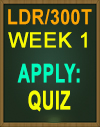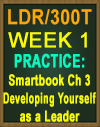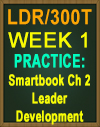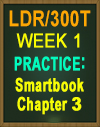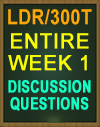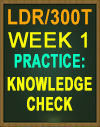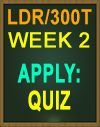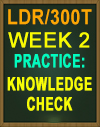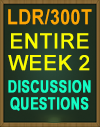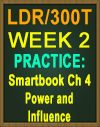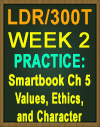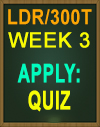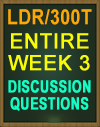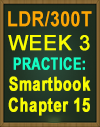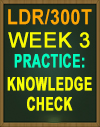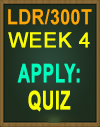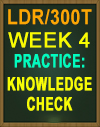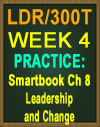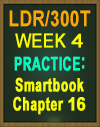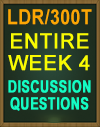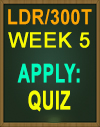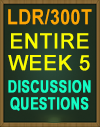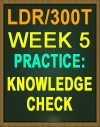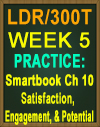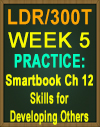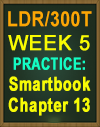LDR/300T Innovative Leadership |
|
|
|
|
|
|
|
|
|
LDR/300T Week 1
Week 1 Tutorial Set includes:
- Practice: Chapter 1 Quiz
- Practice: Chapter 2 Quiz
- Practice: Chapter 3 Quiz
- Practice: Knowledge Check
- Apply: Quiz
- Discussion Question: What it Takes to be a Leader
- Discussion Question: Defining Leadership
Practice: Chapter 1 Quiz
- True or false: Leadership includes something happening as an outcome of the interaction
- between a leader and followers.
- Which of the following skills was most important to the emergence of leadership among the survivors of the 1972 plane crash In the Andes?
- True or false: Most researchers in the field of leadership are in agreement on the basic
- definition of leadership.
- How Parrado managed to convince the survivors of the 1972 Andes plane crash to stage and
- support the final expedition would be most likely examined by researchers who define leadership as ____________.
- Which of the following is a definition of leadership that appears to exclude any kind of coercion as a leadership tool?
- Being familiar with research on leadership can help an individual
- The use of planning techniques is an example of
- Which of the following is not an example of an emotional leader?
- The success of Microsoft 's founder can be attributed to his intelligence, his vision, and _________ among other things.
- All of the following terms are often associated with leadership except
- True or false: A difference between a leader and a manager is that a leader administers while a
- manager innovates.
- Which of the following is not an example of how researchers have defined leadership?
- Which definition of leadership appears to exclude informal leadership?
- Which of the following are true about ideal leaders? (Check all that apply.)
- Which of the following was not a factor in the success of Microsoft's founder Bill Gates?
- The use of planning techniques is an ex ample of
- Which of the following is a myth?
- Which of the following is true of college professors who are considered leaders?
- Which of the following is not a myth?
- True or false: Formal study and learning from experience are mutually exclusive and antagonistic.
- According to Robert Kelley, what are the basic styles of followership? (Check all that apply.)
- Which type of worker is not likely to be more willing to work extra hours on a time-critical project?
- The ___________ theory represented the dominant way of conceptualizing leadership for a long time, but has now been largely discredited
- Which of the following is true of the decision-making process in complex situations?
- Susie lacks enthusiasm, requires constant direction, and relies on her leader to do all the thinking. Susie can be described as a(n)___________follower.
- What choices must managers consider when committing to a company strategy for competing against rival companies?
- A company's ultimate success or failure is fundamentally tied to how well its management team does which of the following?
- A sound company strategy is essentially about _____________ in comparison to company rivals.
- Which performance indicators are signs of a winning strategy?
- In what ways does a competitive advantage benefit a business?
- Which of the following are true statements about crafting and executing strategy?
- The key for a company to achieve competitive advantage is either to provide superior value to customers or to deliver value more _____________.
- What are some of the ways that companies typically implement a competitive strategy?
- By diversifying product lines, by delivering superior customer service, and by focusing on
- Which of the following are reasons for crafting and executing strategies to be important managerial tasks?
- Which statement about the connection between good strategy and good execution is true?
- What are two basic approaches in company strategy to improve chances of success in competing against rivals?
- Which three companies have broad differentiation strategies that have allowed them to maintain long-term competitive advantages?
- The general profit formula for fast-food restaurants as invented by McDonald's involves which of the following?
- Which of the following are the components of a fit test that help evaluate how well a company's strategy matches its situation?
- When a business is more successful than its rival at attracting customers and handling competition, it is said to have a(n) ____________ advantage.
- What performance indicators reveal the most about the merits of a company's strategy?
- What are the two basic ways that companies achieve competitive advantage over their business rivals?
- What is one key characteristic of a focused low-cost strategy?
- A company's approach to meeting or exceeding its customers' needs at a price they consider a good value is called the _____________.
- What company invented the business model for fast food restaurants?
- What are two characteristics of a broad differentiation strategy?
- What is the purpose of the fit test?
- A blueprint that outlines the means for a company to deliver value to customers in a suitably profitable manner is known as its ____________.
- What aspect of a company's operations is usually the easiest thing for competitors to duplicate?
- What are three of the most reliable ways a company can distinguish itself in the marketplace, build customer loyalty, and achieve a competitive advantage?
- The profit ____________ is the company's approach to determining a cost structure that will allow for acceptable profits, given the pricing tied to its customer value proportion.
- Actions taken in response to new strategic maneuvers by rival firms or other unanticipated market circumstances make up a company's _____________ strategy.
- Which circumstances commonly require the modification of a company's strategy?
- When do strategic actions fall into the "should not do" category?
- A typical company's strategy is often both proactive, meaning that it plans ways to improve the company's competitiveness, and ___________, meaning that it responds to unforeseen market conditions.
- The actions that a company takes in accordance with its established business practices makes up its ____________ strategy, in contrast with actions the company takes in response to changing market conditions.
- A company's realized strategy is a combination of ___________.
- A company's business model is comprised of which of the following?
- A business strategy becomes unethical when it involves what elements?
- A strategy that changes in response to new market conditions and challenges is known as ____________.
- It is easier for rivals to imitate a company's product line than it is for them to duplicate its capabilities.
- Which was not the basic issue that emerged among the survivors of the 1972 plane crash in the Andes mountains?
- All of the following are areas of study by leadership researchers except ___.
- True or false: Because of their vast knowledge of the field, leadership scholars are always good leaders.
- According to the text, which is true of leadership?
- According to the leadership myth "Good leadership is all common sense," one needs more than just common sense to be a good leader.
- True or false: Being an expert on leadership research is both necessary and sufficient to being a good leader.
- Identify a true statement about the rational and emotional aspects of leadership.
- Management is often associated with which of the following terms?
- The first researcher to formally recognize the importance of the leader, follower, and situation in the leadership process was
- Which of the following statements is true of the leadership skill?
- Which leader is most likely to gain the respect of followers?
- Fred Fiedler's contingency model of the leadership process included all of the following except
- A review of the 2019 S&P 500 list by the nonprofit organization Catalyst has reported that only ____ percent of CEOs in the United States were women.
- Which type of leader is most likely to get complete and timely information from subordinates?
- Which of the following does not help explain the shift towards more women leaders?
- Which type of follower is likely to be a mediocre performer who is rarely committed to the group's work goals?
- The theory of leadership that argued that leadership is a general personality trait expressed independently of the situation is known as
- The notion of the interaction between leaders, followers, and the situation is best demonstrated by which of the following?
- True or false: Research shows that while women receive more on-the-job mentoring than men, womens' mentors tend to have less clout than mens' mentors.
- The glass _____ refers to the intriguing finding that female candidates for an executive position are more likely to be hired than equally qualified male candidates when an organization's performance is declining.
- True or false: It is essential to consider both context and followers when determining leadership effectiveness.
- Laura is jokingly referred to as a Debbie Downer. She is always quick to point out the negative aspects of the organization. What type of follower is Laura?
Practice: Chapter 2 Quiz
- True or false: Leader development and leadership development refer to the same phenomenon.
- True or false: Individuals who have completed undergraduate courses in leadership are always better leaders.
- Explanations we develop for the behaviors of actions we attend to are called
- The notion that a person being coached must want to change; assessments are important; some behaviors cannot be changes; practice is critical; and there is no substitute for accountability are all
- Mick has taken a new hire, Brian, under his wing and is helping Brian by giving him knowledge, advice, challenge, counsel, and support about career opportunities, organizational strategy and policy, office politics. This process can be described as
- Which is not part of the A-O-R model?
- The question” how do you feel about it now?” is asked in which part of the A-O-R model?
- The term perceptual set refers to
- Fundamental attribution error can best be described as
- The tendency to make external attributions for your own failures yet make internal attributions for your successes refers to
- The fact that people who are watching an action are much more likely than the individual to make a fundamental attribution error can be attributed to
- The findings by Eden and Shani that individuals placed in a high potential group were perceived to have higher potential than those placed in an unknown or regular potential group even though potential was never actually assessed reflects
- True or false: People prefer to explain others’ behavior on the basis of personal attributions even when obvious situational factors may fully account for their behavior.
- Match the types of leadership training programs for leaders and supervisors in industry or public service (in the left column) with their descriptions (in the right column).
- Someone who is ‘learning how to learn’ is using _________ learning.
- The five step informal coaching process is most efficient for
- Which of the following statements regarding formal coaching programs is true?
- Studies of what men and women managers learn from experiences found that taking charge of career was a lesson frequently identified by
- True or false: Developing a strategic plan for the company is a common part of leadership development programs for senior-level executives.
- Which of the following illustrates leader development?
- The action-observation-reflection (A-O-R) model shows that leadership development is enhanced when the experience involves three different processes:
- True or false: People prefer to explain others' behavior on the basis of personal attributions even when obvious situational factors may fully account for the behavior.
- Undergraduate courses in leadership__________.
- The three processes that enhance leadership development are __________.
- A situation in which a student attributes her classmate's bad exam score to a lack of intelligence while the classmate attributes the poor score to unfair grading refers to the _______.
- Our tendency or bias to perceive one thing and not another is referred to as our _______.
- True or false: Self-fulfilling prophecy refers to the explanations we develop for behaviors to which we attend.
- The situation that occurs when one's expectations or predictions play a causal role in bringing about the events one predicts is known as _____.
- Which is not a benefit of reflection?
- An individual who takes credit for successes but blames the situation for failures
- Individuals who are willing to confront their own views are using
- Reflection and facilitated discussion on personal leadership experiences are called ____.
- According to E. Van Velsor and M.W. Hughes, categorize the aspects women and men managers learn from experience.
- True or false: Once an individual has completed a formal education, he or she has the necessary tools for success.
- Perhaps the most important yet most neglected component of the action- observation-reflection model is reflection. Why is reflection important?
- An effective leadership development program will
- When learners seek relatively little feedback that confronts their fundamental ideas or actions they are using
- Which of the following is a leader development method involving the use of leadership situations as a vehicle for leadership discussions?
- True or false: Research shows that individuals who participate in after-event reviews were more effective leaders than individuals who do not participate in the AER process.
- Identify the true statements about leadership training programs aimed particularly toward leaders and supervisors in industry or public service.
- Researchers have studied how male and female executives describe the important lessons they've learned from their career experiences, and found that taking charge of career was a lesson frequently identified by _________.
- An exercise in which participants have a limited amount of time to prioritize and respond to notes, letters, and phone messages from a fictitious manager's in-basket is called
- True or false: To be successful, learning must continue even after the end of one's formal education.
- Academic programs to develop social responsibility and engagement in the local community use ______.
- Which leadership development technique can help identify 'blind spots' an individual may be unaware of?
- Which of the following is a leader development technique that best allows individuals to actually practice skills?
- Which best describes leader development at 3M?
- Programs for first-level supervisors
- Programs for midlevel managers
- Which technique is especially useful for assessing and improving a manager's planning and time management techniques?
- The leader development technique that addresses actual company challenges is called _________.
- When making behavior changes, how many areas should leaders work on at the same time?
- A leadership development program that uses wilderness survival techniques is probably focusing on
- Which of the following should leaders keep in mind when developing their own leadership skills?
- True or false: 3M's commitment to leadership development is illustrated by its decision to make talent development a core business strategy.
- What percentage of the action plan steps in a development plan should be job related?
- Which of the following would most likely not be part of a leadership program for senior executives?
- Which leader development technique focuses on learning by doing?
- Which of the five steps of informal coaching is important to attracting and retaining followers to the work group?
- Which of the following is not a good source of information about behaviors leaders need to change?
- According to the research, which is the most valuable factor in coaching?
- If leaders have more than two development needs, they should _____.
- True or false: Having a written development plan rather than informal goals can help keep leader development on track.
- True or false: Research shows that coaching may be more effective at changing behavior than traditional learning and training approaches.
- Which of the following best identifies when informal coaching takes place?
- Which of the following is not one of the five steps of informal coaching?
- Which method of learning results in the smallest amount of behavioral change?
- How much more do top performers typically contribute to an organization compared to average performers?
- What occurs when an organization assigns a relatively inexperienced, but high-potential leader to one of the top-executives in the company?
- Unlike formal mentoring programs, informal mentoring programs _____.
- All of the following except which is a critical lesson learned from formal coaching?
- Which method of learning results in the greatest amount of behavioral change?
- Identify a true statement about informal mentoring programs.
Practice: Chapter 3 Quiz
- Jayden is a candidate for a managerial position in a tech firm. Identify the questions he should most likely seek answers to during the interview process. (Check all that apply.)
- Which of the following is a key topic that new leaders should discuss with their boss on the first day on their job?
- During the first two weeks on a job, a new leader should do all of these except
- To increase buy-in and support for change decisions, new leaders should _______ their strategy, structure, and staffing ideas with their boss and peers before making personnel decisions.
- True or false: Meeting with peers on a regular basis becomes highly important for a new leader because his or her boss will likely ask peers how the new leader is doing.
- True or false: Leaders can learn a lot by actively observing how others react to and handle different challenges and situations, even common ones.
- Barbara is a candidate for a managerial position in a financial services firm. Identify the tasks she should most likely perform as part of preparing for the interview process. (Check all that apply.)
- The idea of voluntary but determine efforts to improve leadership skills is referred to as ______________.
- Jayden is a candidate for a managerial position in a tech firm. Identify the questions he should most likely seek answers to during the interview process. (Check all that apply.)
- Keeping a journal can be a valuable learning tool for leaders for all of the following reasons except
- Based on research conducted by Peterson and Hicks, arrange the steps in the development planning process for leaders in the correct order of occurrence. (Place the first step at the top.)
- ________ analysis includes goals, actions, perfections, and standards.
- Which of the following statements regarding development plans is true?
- All of the following are helpful for transferring knowledge to new environments except
- Superiors value of the following qualities in followers except
- Which of the following are the typical features of leaders with high levels of technical competence compared to those with lower levels of technical competence? (Check all that apply.)
- True or false: Building rapport with peers is usually unnecessary for individuals who aspire to make it to the top levels of the organization.
- A superior interested in discovering common interests and values of peers should
- True or false: Co-workers should always avoid getting involved with the personal lives of peers.
- The AOR model is a key component in which phase of the Peterson-Hicks development planning process?
- How many development needs should an individual work on at any point in time?
- What is the first step in building technical competence?
- _______ is the best way to become a technical expert.
- Ellie was assigned a team to lead. In her first two weeks, she wanted to find out whether her team members were capable of thinking about, accepting, and driving change. Which question was she most likely to ask?
- Nick is excited about his new job and wants to prioritize his tasks. Identify the task Nick need not perform during the first two months of his new job.
- On the first day on the job, new hires should expect to ______.
- All of the following drive team structure, when new leaders determine the proper direction for their teams except _____.
- Johnson, a new team leader, should meet individually with everyone during the first two weeks on the team if the team has _____.
- Meetings between a new leader and peers should do all of the following except which?
- Identify the advantages of establishing a task force.
- True or false: Individuals who were once part of the team are no longer credible sources of sources of information and their advice should be discounted.
- In the context of creating opportunities to get feedback, identify the true statements about leaders.
- During ______, a leader should work to "socialize" his or her strategy, structure, and staffing ideas with both bosses and peers before making any personal changes.
- When is it especially important for leaders to ask questions in order to learn from others?
- In which situation should a new leader meet individually with team members during the first two weeks on the job?
- Elizabeth wants to maximize the value of her journal. Her entries should do all of the following except:
- Which of the following is not an issue to address during the third month in a new job?
- True or false: Leaders should assume they have invited feedback merely by saying they have an open-door policy.
- Which of the following is not a good source of information for leaders to identify areas for personal improvement?
- Which of the following is not true about leaders who regularly practice the 10 percent stretch except?
- All of the following is true of leaders with high levels of technical competence except
- A leader who wants to develop his technical competence should
- Merely observing how others do things is not nearly as effective as observing and _____________________ about how others do things.
- Which of the following is not true of followers who have good relationships with their superiors?
- True or false: Reading contemporary fiction and classics can help a leader broaden his or her perspective on leadership.
- Which of the following is not true of the superior-follower relationship?
- Shaun's new boss is an outgoing individual who likes to hold frequent face-to-face meetings, but in the past, Shaun has always communicated with his superior via detailed memos. Shaun should
- Individuals who want effective relationships with peers should
- Which of the following is a good springboard for further developmental opportunities?
- A superior interested in discovering common interests and values of peers should _____.
- Which is not an example of a superior?
- True or false: Followers need to realize that superiors do not have all the answers and they have both strengths and weaknesses.
- Individuals practicing a Theory Y attitude should _____.
- In the context of leadership, the systematic process of building knowledge and experience or changing behavior is known as _____.
- Which type of communication is important for discovering common interest and values with peers?
In which part of the GAPS analysis do individuals identify where they want their career to go over the next year?
Which of the following is reinforced among co-workers when there is mutual understanding of the nature of job responsibilities?
- Viewing peers from a ___ perspective assumes that others are competent, trustworthy, willing to cooperate if they can, and proud of their work.
- In which stage of the GAPS analysis is 360 degree feedback helpful?
- Arrange the steps in the development planning process for leaders in a sequential order. Place the first step at the top.
- Which quadrants of the GAPS analysis are future-oriented?
- True or false: Transferring learning to new environments takes place during the second phase of the Peterson-Hicks developmental planning process.
- True or false: A problem with development plans is their failure to include reflection to allow for a change of direction.
- All of the following are beneficial to an effective development plan except
- books on a particular development need.
- The expectations of superiors for your career objectives are relevant during which stage of the GAPS analysis?
- Which is true of a good development plan?
- Which step lets you know whether your high-development development plan is on track?
- Reviewing progress on a development plan can help you ________.
- During the final phase of development planning, the development plan
Apply: Quiz
- Which of the following words is most often associated with the word "management"?
- Unlike the role approach, the constructionist approach
- Which of the following statements is true of women in leadership positions?
- According to leadership researchers, leadership
- Which of the following is a phenomenon that refers to situations in which people feel themselves at risk of being judged by others holding negative images about them?
- According to Robert Kelley's basic styles of followership, which of the following statements is true about pragmatist followers?
- In a classic study of sex roles, Schein
- Identify a true statement about passive followers according to Robert Kelley's basic styles of followership.
- People who are observing an action are much more likely than the actor to make the fundamental attribution error. This is called
- Which of the following statements is true of informal coaching?
- According to Patricia O'Connell's webs of belief, which of the following web is the foundation for leaders to function in complex, uncertain, and changing environments where leadership solutions to challenges depend on mutual trust and respect among parties?
- Which of the following involves participants being given a limited amount of time to prioritize and respond to a number of notes, phone messages, and letters from a fictitious manager's in-basket?
- Kyra, a 16-year-old high school girl, is skeptical about her first day at a new school. She believes that nobody will talk to her and that her new teachers will be rude to her. She enters the class in a negative mood and speaks rudely to everyone. Eventually, she sees that her beliefs about the new school and teachers come true. Which of the following is most likely exemplified in this scenario?
- In the context of perception, which of the following terms is best described as the explanations people develop for the characteristics, behaviors, or actions to which they attend?
- Unlike traditional training programs, action learning
- Which of the following involves a willingness to confront your own views and an invitation to others to do so, too?
- In the context of the first day on the job, identify a true statement about the first meeting of the new leaders with their new bosses.
- What is the fastest way to alter the culture and norms of a team?
- In the context of the new leader onboarding road map, which of the following statements is true of new leaders in the first two weeks?
- Task forces that are formed to work on key change initiatives should be staffed by stars because
- Which of the following leadership styles are supervisors most likely to use when interacting with subordinates with poor technical skills?
- Which of the following statements is true of individuals with high levels of technical competence?
- In the context of the new leader onboarding road map, which of the following steps most likely involves gathering benchmarking information from other organizations, meeting with key external customers and suppliers, and if appropriate, meeting with the former team leader?
- Which of the following statements is true about building effective relationships with superiors?
- Which of the following statements is true of leaders with high levels of technical competence?
- According to Robert Kelley's basic styles of followership, who among the following presents a consistent picture to both leaders and coworkers of being independent, innovative, and willing to stand up to superiors?
- According to Robert Kelley's basic styles of followership, which of the following statements is true about pragmatist followers?
- Craig, a marketing manager at HeliZone Inc., rarely takes initiative or suggests new ideas during project meetings. He does his work half-heartedly and needs to be guided by his manager on a regular basis. According to Robert Kelley's basic styles of followership, Craig most likely is a(n)
- Which of the following definitions of leadership is fairly comprehensive and helpful?
- According to Robert Kelley's basic styles of followership, _____ are the "yes people" of organizations and are very active at doing their organization's work.
- Most early research on leadership was based on the assumption that leadership is a general personal trait expressed independently of the situation in which the leadership is manifested. This view is commonly known as
- Jonathan, a front desk executive at Read Books Inc., handled 40 customer calls per day. He was then sent to a training program last month to improve his communication skills, which cost the organization $500. This month, Read Books observes that his growth is positive and
- ubstantial and that he is able to handle 60 customer calls per day. His productivity has increased by $700. This scenario most likely exemplifies
- The tendency to overestimate the dispositional causes of behavior and underestimate the environmental causes when others fail is called
- Which of the following fundamental archetypes of leadership is most likely to take risks and action in a crisis?
- During the first two weeks on the job, a new leader should conduct in-person meetings with their peers. Which of the following issues should be discussed with the peers?
- Which statement is most likely true about followers having a good working relationship with their superiors?
- What is Hollander's approach to leadership called?
- According to Patricia O'Connell's webs of belief, which of the following webs of belief is associated with respecting and caring for all creation, and honoring the needs and identities of everyone in every culture?
- In the context of the new leader onboarding road map, when should a new leader gather benchmarking information from other organizations, connect with the key external suppliers and customers, and if appropriate, meet with the former leader of the team?
- When building a development plan, one's career objective comes directly from
- Technical competence is especially important for first-line supervisors because they
- Which of the following is one of the best ways to establish and maintain good peer relationships?
LDR/300T Week 1 Knowledge Check
- Which of the following statements is true of women in leadership positions?
- What is Hollander's approach to leadership called?
- In a classic study of sex roles, Schein
- Which of the following involves participants being given a limited amount of time to prioritize and respond to a number of notes, phone messages, and letters from a fictitious manager's in-basket?
- According to Patricia O'Connell's webs of belief, which of the following webs of belief is associated with respecting and caring for all creation, and honoring the needs and identities of everyone in every culture?
- Which of the following statements is true of informal coaching?
- Which of the following is one of the best ways to establish and maintain good peer relationships?
- Which statement is most likely true about followers having a good working relationship with their superiors?
- Technical competence is especially important for first-line supervisors because they
- Which of the following statements is true of leaders with high levels of technical competence?
LDR/300T WEEK 1 Discussion Questions
What it Takes to be a Leader Discussion Question
Complete the Wk 1 Learn: Self-Assessment: Do You Have What It Takes to Be a Leader? in
Connect. Respond to the following in a minimum of 175 words:
It is easy for anybody to delegate tasks in an office, but effective leadership is more than that.
Prominent leaders have significant impacts on the team members they manage and their
company.
Discuss 5 unique perspectives of a good leader.
Discuss the feedback from your self-assessment. As you work toward developing your
leadership skills, how can you apply the feedback to your development to meet an effective
leader's characteristics, activities, and responsibilities?
Defining Leadership Discussion Question
How would you define leadership? Why do you think this is an appropriate definition? How does your definition compare with the one in the textbook, particularly the one offered by the author of the text in the section on Effective Leadership - Who is a leader? How is it similar and how might it be different?
|
|
|
|
|
|
|
LDR/300T Week 2
Week 2 Tutorial Set includes:
- Practice: Chapter 4 Quiz
- Practice: Chapter 5 Quiz
- Practice: Knowledge Check
- Apply: Summative Quiz
- Week 2 Discussion Question - Decision-Making and Leadership Style
- Week 2 Discussion Question - Power and Leadership Discussion
Practice: Chapter 4 Quiz - Power and Influence
- Power is not only related to the leader. What are three aspects that impact power?
- Nancy is seeking to be an effective leader in her new role as regional sales manager. Which of the following leadership principles should Nancy focus on developing with her followers?
- How can the second and third phases of development planning be used to improve as a leader?
- Kathleen is responsible for determining who qualifies for the yearly bonus of her direct reports. Which type of power does she have due to her ability to control this type of desire for resource?
- When evaluating a leader, you should not immediately conclude if the leader is good or bad because you must consider
- Sherry is working on being a better leader. She has created a development plan and is now seeking to implement her plan. In this scenario, which model is best for addressing her leadership abilities?
- Latoya has a desire to become a better leader, but she doesn't know where to start or what areas she should focus on. What systematic process can Latoya use to begin building her leadership knowledge and experience?
- Leaders use which of the following aspects to develop their experience and abilities
- What are the types of power?
- Dr. Hamilton has researched and studied artificial intelligence for over 30 years. Which type of power does he have in that field?
- What is considered the most important, yet neglected, step of the A-O-R Model?
- Emmitt uses his leadership and position to produce effects on others and influence his followers. What term is used to describe this ability of leadership?
- Why is the Action-observation-reflection (AOR) model used in the fourth phase of the development planning process?
- In the past and in eager leadership studies, effective leadership was thought to be based on the heroic theory and included which of the following leadership traits?
- Tovah has been told that he needs to develop his skills as a leader. Which of these tools might best help Tovah?
- The capacity to produce effects on others or the potential to influence others refers to ______.
- One person’s actual behaviors designed to change another person’s attitudes, beliefs, values, or behaviors refers to ________ tactics.
- True or false: As demonstrated by Michelle Obama’s gaffe at a dinner at Buckingham Palace, cultural differences can impact power.
- Individuals in a clique who sit next to each other at a circular table
- In his classic study, Stanley Milgram found that some ____% of individuals followed the requests of their “boss” even though doing so may have gone against their own personal beliefs.
- _______ power is the power of knowledge.
- Which of the following statements regarding referent power is not true?
- Employee of the month and special parking spots are examples of using _______ power to influence behavior.
- Long-term success as a leader requires
- As a result of his decisions in his personal life, Tiger Woods lost which type of power?
- An individual trying to assert power might
- True or false: An individual is likely to be perceived as taller when he is introduced as a professor rather than a student.
- All of the following are bases of power except _______ power.
- A coach deciding who will play in a game is an example of _________ power being exercised.
- According to the text, how people vary in their motivation to influence and control others refers to ____________.
- True or false: McClelland found that individuals with a high need for power are guaranteed leadership success.
- Coercive power can be thought of as being the opposite of ________ power.
- Which types of power are best for a leader to use?
- The Stanford prison experiment highlighted the role of the ______ in the leader power equation.
- Studies by McClelland and also by Miner use which method of assessing the need for power?
- Match the categories of influence tactics used by agents (in the left column) with the situations in which they are typically used (in the right column).
- A minister establishes a committee of church members to help plan the layout and use of a new church addition. In this scenario, the minister uses an influence tactic called _________.
- A sentence that opens with, “John, we have known each other a long time and I have never asked anything of you before” represents the beginning of an influence tactic called _______.
- Several significant people in an alcoholic’s life, such as spouse, children, employer, or neighbor agree to confront the alcoholic in unison about the many dimensions of his or her problem. This is an example of an influence tactic called _________.
- A judge who gives Samuel, a convicted prisoner, a suspended sentence but tells him to consider the suspension a “sword hanging over his head” if he breaks the law again is using an influence tactic called _________.
- An agent makes requests to targets based on his or her position or authority. This scenario exemplifies an influence tactic called _____________.
- Cult leader Jim Jones is an example of a leader using which type of power?
- True or false: Male managers are more likely to involve others when developing strategy.
- True or false: Effective leaders know how the influence tactics they use affect others.
- A salesperson’s good-natured or flattering banter with a customer before the customer makes a decision about purchasing a product is an example of an influence tactic called _________.
- An agent influences a target by giving and taking favors. This scenario exemplifies an influence tactic called
- Power is a function of the leader, the follower, and the
- Many people admire Michael Dell and see him as a role model. Which type of power does Dell have?
- _________is the actual change in a target person's attitudes, values, beliefs, or behaviors.
- An individual trying to assert power might
- Which of the following is not true?
- The capacity to produce effects on others or the potential to influence others refers to
- If you want to minimize status differentials with subordinates, what should you do at a meeting with them?
- As a result of his decisions in his personal life, Tiger Woods lost which type of power?
- True or false: Stanley Milgram found that many people will obey an authority figure even when doing so is in conflict with their conscience.
- The change in a target agent's attitudes, values, beliefs, or behaviors as the result of influence tactics refers to _______.
- Which of the following is likely to have the least amount of power?
- The status differential between members of a group is called the _____.
- All of the following are bases of power except ____ power.
- True or false: As demonstrated by Michelle Obama's gaffe at a dinner at Buckingham Palace, cultural differences can impact power.
- ________power is the power of knowledge.
- Individuals in a clique who sit next to each other at a circular table
- The potential influence one has due to the strength of the relationship between the leader and the follower is referred to as ___________ power.
- In his classic study, Stanley Milgram found that some ____% of individuals followed the requests of their "boss" even though doing so may have gone against their own personal beliefs.
- An individual's formal or official authority is called ______ power.
- Which type of power is most likely to be used in a crisis situation?
- Employee of the month and special parking spots are examples of using ____ power to influence behavior.
- _____ power is primarily a function of the situation.
- In order to be successful in the operating room, a brain surgeon must have ______ power.
- A policeman giving a ticket is an example of ____ power.
- A coach deciding who will play in a game is an example of __________ power being exercised.
- The Stanford prison experiment highlighted the role of the ____ in the leader power equation.
- The potential to influence others due to one's control over desired resources is __________ power.
- Cult leader Jim Jones is an example of a leader using _____ power.
- Which types of power are best for a leader to use?
- Coercive power can be thought of as being the opposite of ______ power.
- Individuals who are relatively selfish, impulsive, uninhibited, and lacking in self-control have a high need for which type of power?
- The potential influence one has due to the strength of the relationship between the leader and the follower is referred to as __________ power.
- Which of the following is not one of the six composites that comprise Miner's motivation to manage?
- Which of the following is an effective team leader's ideal job?
- True or false: McClelland found that individuals with a high need for power are guaranteed leadership success.
- The actions of the Taliban against women in Afghanistan is an example of using which type of power?
- A politician's adviser explains how demographic changes in the politician's district make it important for the politician to spend relatively more time in the district seeing constituents than he or she has in the recent past. In the context of influence tactics, this scenario is most likely an example of _____.
- True or false: Good leaders are open to being influenced by subordinates.
- An agent makes a request or proposal designed to arouse enthusiasm or emotions in a target person. In this scenario, the agent uses an influence tactic called _____.
- According to the text, how people vary in their motivation to influence and control others refers to _______..
- A minister establishes a committee of church members to help plan the layout and use of a new church addition. In this scenario, the minister uses an influence tactic called _____.
- Studies by McClelland and also by Miner use which method of assessing the need for power?
- A salesperson's good-natured or flattering banter with a customer before the customer makes a decision about purchasing a product is an example of an influence tactic called _____.
- Long-term success as a leader requires
- A sentence that opens with, "John, we have known each other a long time and I have never asked anything of you before" represents the beginning of an influence tactic called _____.
- An agent uses logical arguments or factual evidence to influence others. This scenario exemplifies an influence tactic called _____.
- A minister's impassioned plea to members of a congregation about the good works that could be accomplished if a proposed addition to the church were built is an example of an influence tactic called _____.
- An agent influences a target by giving and taking favors. This scenario exemplifies an influence tactic called
- An agent asks a target to participate in planning an activity. In this scenario, the agent uses an influence tactic called _____.
- Several significant people in an alcoholic's life, such as spouse, children, employer, or neighbor, agree to confront the alcoholic in unison about the many dimensions of his or her problem. This is an example of an influence tactic called _____.
- In the context of influence tactics, when an agent attempts to get a target person in a good mood before making a request,
- A judge who gives Samuel, a convicted prisoner, a suspended sentence but tells him to consider the suspension a "sword hanging over his head" if he breaks the law again is using an influence tactic called _____.
- Agents ask another to do a favor out of friendship. In this scenario, the agents use an influence tactic called _____.
- An agent makes requests to targets based on his or her position or authority. This scenario exemplifies an influence tactic called _____.
- Match the categories of influence tactics used by agents (in the left column) with the situations in which they are typically used (in the right column).
- Two politicians agree to vote for each other's pet legislation despite minor misgivings about each other's bills. This scenario exemplifies an influence tactic called _____.
- Which of the following is not true of female managers?
- In the context of influence tactics, identify a feature of coalition tactics that is different from that of consultation.
- True or false: Effective leaders know how the influence tactics they use affect others.
- An agent uses threats or persistent reminders to influence targets. This scenario exemplifies an influence tactic called _____.
- A principal asks a teacher to be on the school's curriculum committee, and the teacher accedes to the request despite reservations because it is the principal's prerogative to appoint any teacher to that role. This scenario exemplifies an influence tactic called ______________.
- Match the categories of influence tactics used by agents (in the left column) with the tactics included in them (in the right column).
- True or false: Male managers are more likely to involve others when developing strategy.
Practice: Chapter 5 Quiz
- The Association of Certified Fraud Examiners estimates that globally businesses lose how much each year due to fraudulent activity?
- Principles of right conduct or a system of moral values are referred to as _________.
- Leaders who show they understand the world as we see and experience it show ________.
- Successful managers typically subscribe to
- Prejudice that occurs without the individual’s awareness refers to ________ prejudice.
- A manager who chooses a job applicant who is more like herself rather than another applicant who is not like her is demonstrating _____________.
- When we overestimate the quality of our own work and contributions to our team, we are showing which type of bias?
- Research shows that the relationship between how we think we should act and our actual behavior is
- Individuals like Sergeant York who rationalize their behavior as they fight and kill in war situations use ____________ justification.
- The fortitude to face risk and overcome fears associated with taking ethical action refers to moral
- __________ doubt the wisdom of traditional racial and sexual categorizing and seek seeking teamwork, security, and work-life balance as they move into the workplace.
- Values that refer to modes of behavior are called ______________ values.
- The group of workers identified by Zemke as entrepreneurial individuals who embrace change and take a free agency approach to their jobs are the _____________.
- Plato and Kant believed mature moral judgment was a __________ process.
- A researcher who ask subordinates to speculate whether they think their manager would be likely to act unethically is using a ___________ reputation approach to measuring leader integrity.
- Constructs representing generalized behaviors or states of affairs that are considered by the individual to be important are known as
- The question of whether you should tell authorities that your spouse has a highly contagious and dangerous disease or protect her privacy is an example of which ethical dilemma?
- The notion of ‘do what you want other to do to you’ refers to which type of thinking?
- True or false: One’s ethical judgments are negatively affected by conflicts of interest.
- A leader who’s primary motivation is to help others can best be described as __________ leaders.
- __________ represents an organization’s purpose, guiding principles, basic identity, and most importance values. (Answer using two words.)
- Which of the following is not true regarding personal values and organizational values?
- Which employee is least likely to address perceived ethical problems?
- Firms that compete using a focus strategy are said to focus on
- Michael Porter presented three Blank______ strategies to achieve competitive advantage by overcoming the five forces.
- Research has found that companies that
- A successful overall cost leadership strategy requires a tight set of interrelated tactics that include which of the following?
- Salvamoser Steel fabricates widgets. When the company first began production, it had high unit costs because it was trying to figure out the most efficient manufacturing method. After a few years, Salvamoser Steel had ironed out its production issues, and unit costs of production declined, even as cumulative output increased. This is known as
- An overall cost leadership strategy is a strategy based on managing relationships
- True or false: A firm experiences competitive parity with competing firms when they capture so much of its market share that it is left with no profits.
A common pitfall of using a cost-leadership strategy is that
- ______ is the decline in unit costs of production as cumulative output increases.
- Which type of strategy is based on creating differences in the firm's product or service offering by creating something that is perceived industrywide as unique and valued by customers?
- ______ is a firm's achievement of similarity, or being "on par," with competitors with respect to low cost, differentiation, or other strategic product characteristics.
- A firm that follows a differentiation strategy for competitive advantage still needs to be mindful of maintaining cost
- ____ relative to competitors by lowering costs in features that customers care less about.
- The breadth of the target market refers to
- A differentiation strategy can improve a company's position vis-a-vis Porter's forces due to which of the following? (Check all that apply.)
- Which of the following are ways an overall cost leadership strategy can improve a company's position vis-a-vis Porter's forces? (Check all that apply.)
- Which of the following are potential pitfalls of using an overall cost leadership strategy? (Check all that apply.)
- Companies that use differentiation strategies may use which of the following to differentiate their products or services? (Check all that apply.)
- Which of the following are reasons a differentiation strategy may not succeed? (Check all that apply.)
- Which of the following statements regarding maintaining cost parity are true? (Check all that apply.)
- A ______ strategy is a firm's generic strategy based on appeal to a narrow market segment within an industry.
- Firms that use a differentiation strategy may be able to decrease buyer power ______.
- Which of the following are pitfalls of using a focus strategy? (Check all that apply.)
- Which of the following statements regarding combination strategies are correct? (Check all that apply.)
- Which of the following are potential pitfalls of using a differentiation strategy? (Check all that apply.)
- What term describes the strategy of building smaller operations in order to combine low cost and differentiation while meeting the needs of a specific group of customers in an efficient manner?
- Focus strategies exploit
Which of the following are potential pitfalls of using a focus strategy? (Check all that apply.)
- The ability of some firms to manufacture unique products in relatively small quantities at lower costs is due to advances in Blank______ technologies.
- An industry's profit pool is the total profits at all points along its ____chain.
- Combination strategies likely provide value through
- Which of the following are benefits when companies successfully integrate cost and differentiation advantages create an enviable position? (Check all that apply.)
- Which of the following are ways that companies can combine overall cost leadership and differentiation? (Check all that apply.)
- Which of the following are pitfalls of using a combination strategy? (Check all that apply.)
- Which statement is true about the duration of competitive advantages in modern business?
- A firm's ability to manufacture unique products in small quantities at low cost is known as
- An industry's ________ is the total profits at all points along its value chain.
- Which of the following statements about platform markets is true?
- Which of the following are ways that a combination strategy can improve a company's position vis-a-vis Porter's forces? (Check all that apply.)
- Companies that are not able to create a competitive advantage through both cost leadership and differentiation strategies
- In order to most effectively sequence the growth of a platform business, what two factors should managers take into account?
- Which of the following can erode a company's competitive advantage? (Check all that apply.)
- Which of the following are two challenges of the introduction stage of the industry life cycle? (Check all that apply.)
- Which of the following are issues for platform businesses? (Choose all that apply.)
- Revenues increase during the ______stage of the industry life cycle as new customers try the product and an ever-increasing number of satisfied customers make repeat purchases.
- Which of the following are characteristics of the industry life cycle's maturity stage? (Check all that apply.)
- The introduction stage of the industry life cycle is characterized by which of the following characteristics? (Check all that apply.)
- Companies that use a ______ positioning strategy offer products with fewer product attributes and lower prices, in contrast to the industry tendency to continuously augment products as part of the product life cycle.
- Which of the following are two requirements for successfully introducing a new product? (Check all that apply.)
- ______ is to offer a product in a different category to create the perception that the product is altogether different.
- Which of the following are characteristics of the growth stage? (Check all that apply.)
- Revenues grow during the growth stage due to which of the following? (Check all that apply.)
- Which of the following are characteristics of the decline stage of the industry life cycle? (Check all that apply.)
- Which of the following are goals of reverse positioning? (Check all that apply.)
- Which of the following are characteristics of products that are in the decline stage? (Check all that apply.)
- Which of the following is a firm able to do when it successfully enters a new category with a breakaway product?
- Maintaining, harvesting, consolidating, and exiting are the four basic strategies available in the Blank______ phase.
- ______ refers to keeping a product going without significantly reducing marketing support, technological development, or other investments, in the hope that competitors will eventually exit the market.
- One reason for a company to use a harvesting strategy for a declining product is to
- Firms that sell products in a declining industry are often affected by which of the following competitor actions? (Check all that apply.)
- One reason a company would use a maintaining strategy for a declining stage product would be
- True or false: One component of asset and cost surgery for a mature company is to outsource production when market prices are less than in-house production costs.
- JK Industries is a diversified company that has been in business for decades. Its healthcare division has been profitable, but its line of prestige beauty products has been losing money. JK decides to discontinue its line of prestige beauty products and focus its efforts on the healthcare lines that have been most promising. Which strategy is JK using?
- Companies that exit markets need to be aware of
- Companies that use a consolidation strategy in a declining industry
- ______________ is when firms in a turnaround situation seek to eliminate costs and improve productivity through small gains that accumulate over a period of time.
- Which actions should be taken when implementing a retrenchment strategy? (Choose all that apply.)
- ______ is when firms are in a turnaround situation and aggressively cut administrative expenses and inventories and speed up receivable collections.
- Which of the following are examples of piecemeal productivity improvements? (Check all that apply.)
- The breadth of the target market refers to ______.
- Companies that cannot identify any type of competitive advantage are classified as ______.
______ is a generic strategy based on appeal to the industrywide market using a competitive advantage based on ______.
- ______ is the decline in unit costs of production as cumulative output increases.
- Michael Porter presented three ______ strategies to achieve competitive advantage by overcoming the five forces.
- A common pitfall of using a cost-leadership strategy is that ______.
- An overall cost leadership strategy helps companies erect substantial industry entry barriers through ______.
- When referring to competitive advantage, what does "type" refer to?
- When an organization has a service culture, the result is ___________.
- An advantage of practicing a safety-oriented culture in an organization is that it results in ________________.
- Employee satisfaction and organizational commitment are negatively affected by tall organizational structures because _____________.
- When an organization grows in size, the changes in the organizational structure lead to necessary _____________.
- The main aim of a ___________ in an organization is to concentrate on new products, services, and operational innovations.
- According to John Gardner's view on a true community, a community's need for fruitful external relationships conflicts with its need to _____________.
- The character and norms of behavior in an organization are primarily defined by its ___________.
- According to John Gardner's views on true community, internal communications in a well-functioning community is _____________.
- When satisfying a customer is given priority in an organization, the organization exhibits a ___________ culture.
- In the context of Jay Conger's article, the most important task faced by leaders currently is _______________.
- Why do enlightened and supportive organizations indicate good investments?
- In an exploitive type of leadership, ____________.
- Scott Peck, in his book, observes that a potential hurdle to the creation of a community is the _____________.
- According to Jay Conger, the two basic leadership competencies that combine to create a community are _____________.
- In an enlightened leadership, power is delegated ____________.
- John Gardner believes that a healthy and successful community reaffirms itself continuously and thus develops the community's ____________.
- In a failing Pattern II organization, ___________.
- In a community that is experienced as "a group of people," people _____________.
- In an organization, storytelling can be used to _____________.
- When a community is experienced as "a way of being," people _____________.
- An organization is influenced the most by stories when they ___________.
- What is the relationship between leaders and members in a Pattern II leadership?
- Thomas Carlyle believed that people have a need for __________.
- In an organization that has an impoverished leadership, members are ___________.
- According to John Gardner, a shared culture _________.
- Organizations having an autocratic hierarchy rarely survive in a free social and economic order because ______________.
- Excessive layers of management can lead to ____________.
- In an organization having supportive leadership, members ____________.
- A _________ culture is an organizational culture where the most important objectives are to promote work conditions and behaviors that prevent accidents and injuries.
- Pattern II organizations that are successful exhibit a benevolent autocracy where ___________.
- An organization where leaders attempt to avoid an autocratic hierarchy is considered to have an ____________ culture.
Practice: Week 2 Knowledge Check (With Extra Questions/Answers)
- Identify a true statement about socialized power.
- The ability to control others through the fear of punishment or the loss of valued outcomes is known as
- People tend to use rational tactics when
- Followers are highly likely to use _______ power to change their leader’s behavior if they have a relatively high amount of referent power with their fellow coworkers.
- ______ occurs when agents ask targets to participate in planning an activity.
- Dr. Jonathon realizes that his patient is suffering from a highly contagious disease that is likely to pose a threat to the entire city. However, he is uncertain about sharing this information with city officials to protect his patient’s privacy. In this scenario, which of the following ethical dilemmas does the doctor most likely face?
- Terrorists may call themselves ‘freedom fighters’ and firing someone may be referred to as ‘letting him or her go’. These are both examples of
- Which of the following is an approach developed and popularized by Covey, which postulates a fundamental interdependence between the personal, the interpersonal, the managerial, and the organizational levels of leadership?
- What are the four qualities of leadership that engender trust according to Bennis and Goldsmith?
- A leader who has developed close interpersonal relationships with followers generally uses his or her ________ power to influence them.
- A police officer giving a speeding ticket to a driver is most likely using his or her
- Which of the following statements concerning power & influence is most likely FALSE?
- Which of the following statements is true of legitimate power:
- Which of the following generation of workers tends to be technologically savvy, independent, and skeptical of institutions and hierarchy?
- According to Zemke’s four generations of workers, which of the following statements is most likely true of Veterans?
- According to Zemke's four generations of workers, the Millennials
- According to Zemke's four generations of workers, which of the following statements is most likely true of the Baby Boomers?
- Which of the following is an intrinsic reward?
- ________ is exercised in the service of high goals to others or organizations and often involves self-sacrifice toward those ends
- A politician's advisor explains how demographic changes in the politician's district make it important for the politician to spend more time in the district seeing constituents that she has in the past. This is an example of
- Which of the following is occurring when agents ask targets to participate in planning an activity?
- A judge who gives a convicted prisoner a suspended sentence but tells him to consider the suspension a "sword hanging over your head" if he breaks the law again using
- Rational tactics are most likely used by a person when
- Coalition tacts are most likely exhibited when agents
- People typically use hard tactics when
Apply: Quiz
- Sherry is working on being a better leader. She has created a development plan and is now seeking to implement her plan. In this scenario, which model is best for addressing her leadership abilities?
- When compared to other methods, this can be the most effective way to learn leadership skills:
- Jim is a manager in a retail business. To be an effective manager and active leader, Jim should try to have how many people as direct reports?
- How can the second and third phases of development planning be used to improve as a leader?
- When evaluating a leader, you should not immediately conclude if the leader is good or bad because you must consider
- Tovah has been told that he needs to develop his skills as a leader. Which of these tools might best help Tovah?
- Why is the Action-observation-reflection (AOR) model used in the fourth phase of the development planning process?
- What is the term for the actual tactics for actions used by an agent to change the attitudes or behaviors of a target person?
- Power is not only related to the leader. What are three aspects that impact power?
- Leaders, as opposed to strictly managers, are involved in which one of the following activities?
- As the HR manager of her corporation, Maria is responsible for documenting formal warnings and sanctions due to misbehavior and poor performance. Which type of power does Maria wield?
- Which type of power can Lee use in his role as the CEO in an organization?
- What are the types of power?
- What is the considered the most important, yet neglected, step of the A-O-R Model?
- Devin just completed a GAPS analysis. What should he do now to further his development plan?
- Latoya has a desire to become a better leader, but she doesn’t know where to start or what areas she should focus on. What systematic process can Latoya use to begin building her leadership knowledge and experience?
- Leaders use which of the following aspects to develop their experience and abilities:
- What are the three important parts of leadership that determine how effective a leader is?
- In the past and in early leadership studies, effective leadership was thought to be based on heroic theory and included which of the following leadership traits?
- Kathleen is responsible for determining who qualifies for the yearly bonus of her direct reports. Which type of power does she have due to her ability to control this type of desire for resource?
- Emmitt uses his leadership and position to produce effects on others and influence his followers. What term is used to describe this ability of leadership?
- Dr. Hamilton has researched and studied artificial intelligence for over 30 years. Which type of power does he have in that field?
- What is the first phase of development planning for a leader?
- Michael has a strong relationship of trust with one of his direct reports, Jenny. Which type of power can Michael use due to this relationship?
LDR/300T WEEK 2 Discussion Questions
Discussion - Power and Leadership
Discuss 3 types of power the leader has. How is it helpful in enacting change within the leader's sphere of influence? Discuss 1 reason to know if the person's leadership skill is inherent or developed over time?
Discussion - Traits as Part of Leadership
Includes 3 Full Answers to this Discussion Question! A+ Work!
Do you think some people are born leaders and can rise to the top no matter what the situation? Why/why not? If so, what key characteristics do they need to possess?
|
|
|
|
| |
|
LDR/300T Week 3
Week 3 Tutorial Set includes:
- Practice: Chapter 15 Quiz
- Practice: Knowledge Check
- Apply: Quiz
- Discussion Question: What it Takes to be a Leader
- Discussion Question: Defining Leadership
Practice: Chapter 15 Quiz
-
- The _____ ________ Questionnaire is a 360-degree feedback instrument that assesses five transformational and three transactional factors and a nonleadership factor.
- Which of the following are research results of transformational and transactional or laissez-faire leadership? (Check all that apply.)
- A leader who anticipates that problems could occur in manufacturing or customer service after changes are implemented to the compensation system to motivate sales people is using the ____ approach.
- When leaders act to optimize their part of the organization at the expense of suboptimizing the organization’s overall effectiveness, the leader is using ________ thinking.
- In which component of the change model does the change initiative become tangible and actionable?
- There is often a temporary drop in performance or productivity as followers learn new systems and skills. This difference between initial expectations and reality is called the _____________ gap and can be the source of considerable frustration.
- To date, over 350 studies have used the Multifactor Leadership Questionnaire (MLQ) to investigate transformational and transactional leadership across a wide variety of situations. Which of the following is a result of these studies?
- In the context of research on transformational leadership, Zacharatos, Barling, and Kelloway reported that _________________.
- Which of the following are research results of transformational and transactional or laissez-faire leadership? (Check all that apply.)
- Which of the following best describes the acceptance by followers of the vision of a charismatic leader?
- Which of the following is NOT true?
- Which of the following BEST describes the relationship between followers and a charismatic leader?
- The system in which British citizens pay large sums of money in the form of taxes to support the queen reflects a ___________.
- Which theory argues that leaders do not treat all followers as if they were a uniform group of equals?
- Which contingency model generates the most research?
- Which type of leader is NOT likely to be a transformational leader?
- Which is true of charismatic leaders and social networks?
- Kleptocracy
- Malicious compliance
- Which model is concerned with how the leader's behavior can be changed to improve interactions with different followers?
- Followers' emotions are the fuel for organizational change and change often requires a considerable amount of fuel. The key for leadership practitioners is to _________.
- Who is likely to progress through the SARA model first?
- Siloed thinking
- Span of control, team composition and hierarchy are all part of which component?
- Transformational leaders in a firm build trust in their leadership and the attainability of their goals through a(n) ________ of seemingly unshakable self-confidence, strength of moral conviction, personal example and self-sacrifice, and unconventional tactics or behavior.
- Image
- __________ leadership skills involves behaviors associated with being able to successfully flex and adjust to changing situations.
- SARA model
- Organization's vision
- Organization's goal
- The capability and willingness to learn from experience and apply these lessons to new situations refers to which of the following?
- Leadership that typically does not result in organizational or societal change, but rather perpetuates and legitimize the status quo is called _________ leadership.
- Strategic goals are reflected in the ________ component.
- The most important and overlooked situational variable affecting charismatic leadership is _________.
- Leadership that changes the status quo by appealing to followers' values and their sense of higher purpose can best be described as ________.
- The extent to which a leader spells out the responsibilities of individual or group refers to _____
- behavior.
- True or false: Follower readiness is an assessment of an individual's personality, traits, values, and so
- forth.
- In which authority system do people derive authority because of their exemplary characteristics?
- The ability of John Kerry, in his position as Secretary of State, to take certain actions reflects which authority system?
- Legal-rational authority system
- In a ________ authority system, a person possesses authority not because of tradition or birthright, but because of the laws that govern the position occupied.
- Charismatic authority system
- Traditional authority system
- Transactional leadership
- Transformational leadership
- True or False. Followers who are content with the status quo are most likely to perceive a need for a charismatic leader or be willing to devote great effort to fundamentally change an
- Which of the following is NOT part of good succession planning?
- Which of the following is an example of a vision statement?
- A __________ is a system in which people pay large tributes to a small group of people at the top, but get little in return.
- The _______ _______ outlines the sequence of events, key deliverables, time lines, responsible parties, metrics, and feedback needed to achieve new organizational goals.
- The authority system in which the traditions or unwritten laws of the society dictate who has authority and how this authority can be used is the ___________ system.
- In an organizational context, followers' level of satisfaction is an important ingredient in a leader's ability to drive change.
- How are today's leaders using technology to incite dissatisfaction and change?
- Which of the following is true?
- True or False. Willing subordination to the leader involves the deference of followers to his or her authority.
- In Beer's model of organizational change, 'C' refers to amount of _____________.
- In Beer's model of organizational change, 'M' refers to amount of ____________.
- In Beer's model of organizational change, 'P' refers to amount of ____________.
- In Beer's model of organizational change, 'D' refers to amount of _____________.
- Adaptive leadership
- Most effective leaders are those with
- Crisis, organizational culture, competitive threats, and societal shifts are all part of which component of the interactional framework?
- The reactions to change of shock, anger, rejection, and acceptance refer to the _________ model.
- A strong emotional reaction to, identification with, and belief in some leaders by followers refers to ___________.
- Feelings of empowerment and heightened emotional levels are part of which component of the interactional framework?
- Charisma.
- Charismatic leaders in an organization are able to stir followers' feelings, and this heightened emotional level results in ___________.
- Which of the following is NOT TRUE about followers' regard for their charismatic leader's authority?
- Which of the following is NOT TRUE of charismatic leaders and their followers?
- In-group and out-group interactions are the focus of which theory?
- If a particular follower has low task readiness, Hersey and Blanchard's Situational Leadership model maintains that the leader should use a _____ when initially dealing with this follower.
- True or false: The LMX model is particularly valuable because it identifies the specific behaviors
- that lead to high quality relationships between leaders and followers.
- The question 'what is the task to be accomplished' is concerned with which part of the interactional framework?
- The ________ ________model addresses the question of whether there is an optimum way for
- leaders to adjust their behavior with different followers to increase the likelihood of a successful
- interaction.
- Which model suggests that leader effectiveness is primarily determined by selecting the right kind of leader for a certain situation or changing the situation to fit the particular leader's style?
- Telling people what to do, how to do it, and when to do it are all examples of _____ behavior.
- To determine a leader’s general style or tendency, Fiedler developed an instrument called the
- ________ preferred coworker scale.
- A follower's ability and willingness to accomplish a particular task refers to follower ________.
- The extent to which relationships between the leader and followers are generally cooperative and friendly or antagonistic and difficult is concerned with _____.
- A follower has both substantial training and experience in a required task. According to Hersey and Blanchard's Situational Leadership model, which of the following leadership behaviors should the leader exhibit in this scenario?
- According to Fiedler, match the types of leaders based on their least preferred co-worker (LPC) scores (in the left column) with their behaviors when faced with unfavorable or moderately favorable situations (in the right column).
- Which of the following is true of the Situational Leadership model?
- Which model is the most validated of all leadership theories?
- Which of the following is the earliest and most well-known contingency theory?
- Which theory would best provide perspective on the question 'if I study for 12 hours, what is the probability that I'll get an A on the exam?'
- True or false: The score on the least preferred coworker scale reflects something about the leader, not the specific individual the leader evaluated.
- Which type of leaders share work problems with followers and weigh the input of followers when making decisions?
- According to the contingency model, the amount of control the leader has over followers refers to ________________.
- According to Mitchell, Smyser, and Weed's study based on the path–goal theory of leadership, match the types of followers based on their loci of control (in the left column) with the corresponding findings related to leader behaviors (in the right column).
- Fiedler and his associates have conducted numerous studies to determine how different leaders, as described by their least preferred co-worker (LPC) scores, have performed in different situations. Match the types of situations (in the left column) with the corresponding results (in the right column).
- The contingency model's task structure and position power are concerned with which part of the interactional framework?
- True or false: According to the path–goal theory of leadership, factors that influence leadership situations can serve as an independent motivational factor, as a constraint on the behavior of followers, or as a reward.
- Expressing genuine concern for the well-being of followers and remaining open and approachable to followers are examples of which type of leadership?
- According to the path–goal theory of leadership, followers will actively support a leader as long as _______________.
- Path-goal theory would suggest that a leader dealing with a newly formed work unit that has a high level of ambiguity should
- Path-goal theory has received _________ research support.
- What are the situational factors considered by the path–goal theory of leadership that impact or moderate the effects of leader behavior on follower attitudes and behaviors? (Check all that apply.)
- True or false: Path-goal theory maintains that leaders should first assess the situation and then choose a leadership behavior appropriate to the situation.
- The norms, cohesiveness, size, and stage of development of groups are part of the _____ function in the L-F-S model, but are part of the _____ function in path-goal theory.
- Which theory argues that leaders do not treat all followers as if they were a uniform group of equals?
- According to the LMX theory, during the _______ stage, similarities and differences become cemented.
- To enhance the overall effectiveness of the organization, leaders should do all of the following except which?
- Which contingency model generates the most research?
- Will one alternative have a greater cost savings than the other? Is a question to ask when trying to understand decision _________.
- Decision _____________ implies that followers accept the decision as if it were their own and do not merely comply with the decision.
- Which of the following are typically considered the problems with the normative decision model of leadership? (Check all that apply.)
- Which of the following is concerned with how much input subordinates should have in the decision-making process?
- In the context of leadership effectiveness, which of the following represents the autocratic level of participation in the normative decision model?
- Which of the following is tru about the normative decision model of leadership when it is viewed through the leader-follower-situation (L-F-S) framework?
- In the context of leadership effectiveness, which of the following is true of the autocratic level of participation in the normative decision model?
- Which of the following questions are part of Vroom and Yetton’s leadership decision tree that helps leaders determine how much participation subordinates should have to optimize decision quality and acceptance related to a problem? (Check all that apply.)
- Analyze the given image of Hersey and Blanchard’s Situational Leadership model, and classify the aspects of follower readiness under the corresponding parties that direct these aspects.
- A follower has both substantial training and experience in a required task. According to Hersey and Blanchard’s Situational Leadership model, which of the following leadership behaviors should the leader exhibit in this scenario?
- What are the situational factors considered by the path-goal theory of leadership that impact or moderate the effects of leader behavior on follower attitudes and behaviors? (Check all that apply.)
Practice: Knowledge Check
- According to the path-goal theory, a leader should assess a situation and select a leadership behavior appropriate to situational demands.
- The path-goal theory assumes that leaders user the same styles with different subordinates.
- With Situational Leadership, follower readiness refers to a follower’s ability and willingness to accomplish a particular task.
- According to the path-goal theory, followers will actively support a leader as long as they view the leader’s actions as a means for increasing their own levels of satisfaction.
- Low-LPC leaders will focus on improving their relationships with followers after they are assured that assigned tasks are being satisfactorily accomplished
- What should leaders first asses in order to apply the Situational Leadership model?
- In the context of the four types of leader behavior in the path-goal theory which leadership behavior is most likely characterized by telling followers what they are expected to do, how to do it, when it is to be done, and how their work fits in with the work of others.
- In the context of the Situational Leadership model, which of the following is a relationship behavior?
- In the context of the four types of leader behavior in the path-goal theory, which of the following is most likely a characteristic of achievement-oriented leadership?
Apply: Quiz
- What should leaders first assess in order to apply the Situational Leadership model?
- In the context of the levels of participation in the normative decision model, which of the following is most likely true of consultative processes?
- Which of the following instruments does Fiedler's contingency theory use to determine the relevant characteristics of a leader?
- Which of the following statements about the path–goal theory is most likely false?
- If a decision has a rational or objectively determinable "better or worse" alternative, a leader should select the better alternative. This most likely refers to
- In the context of the Situational Leadership model, which of the following depicts selling as a leadership behavior?
- Which of the following statements about high-LPC leaders is most likely true?
- In terms of the path–goal theory, which of the following is considered a situational factor?
- In the context of the contingency model, which of the following is the most powerful element of situational favorability?
- In the context of the four types of leader behavior in the path–goal theory, which of the following is most likely a characteristic of achievement-oriented leadership?
- In the context of the Situational Leadership model, which of the following is a relationship behavior?
- Which of the following statements about the normative decision model is true?
- In the context of the Situational Leadership model, which of the following was defined as the extent to which a leader spells out the responsibilities of an individual or group?
- According to Hershey, leaders should implement a series of developmental interventions in order to increase follower readiness levels for particular tasks by first assessing a follower's current level of readiness and then determining the leader behavior that best suits that follower in that task.
- According to the path–goal theory, follower satisfaction is directly related to the degree of participative behaviors manifested by a leader.
- According to the path–goal theory, a leader should assess a situation and select a leadership behavior appropriate to situational demands.
- In the routinization stage of development of the leader–member exchange theory, similarities (for the in-group) and differences (often accentuated for the out-group) become cemented.
- With Situational Leadership, follower readiness refers to a follower's ability and willingness to accomplish a particular task.
- Vroom and Yetton's normative decision model is directed solely at determining how much input subordinates should have in the decision-making process.
- In the context of contingency theory, the least preferred co-worker (LPC) score is intended to represent follower behaviors and situational factors.
- The normative decision model shifts focus away from the situation and the followers to the leader.
- The path–goal theory assumes that leaders use the same styles with different subordinates.
- The contingency model of leadership maintains that leaders are extremely flexible in their behavior.
- Low-LPC leaders will focus on improving their relationships with followers after they are assured that assigned tasks are being satisfactorily accomplished.
- Situational Leadership is a useful way of getting leaders to think about how leadership effectiveness may depend on being flexible with different subordinates.
- Which two broad categories of leader behaviors did the Situational Leadership model originally identify?
- In the context of the leader–member exchange (LMX) theory, which of the following statements is true of the role-taking stage of development?
- The highest levels of situational favorability most likely occur when leader–member relations are good, the task is structured, and position power is high.
- Which of the following statements is true of the Situational Leadership model?
- In the context of the four types of leader behavior in the path–goal theory, which leadership behavior is most likely characterized by telling followers what they are expected to do, how to do it, when it is to be done, and how their work fits in with the work of others?
- In the context of the Situational Leadership model, which of the following best defines follower readiness?
- Position power is not a characteristic of leaders but of the situations that leaders find themselves in.
- The path–goal theory considers three situational factors that moderate the effects of leader behavior on follower behavior.
- According to the path–goal theory, followers will actively support a leader as long as they view the leader's actions as a means for increasing their own levels of satisfaction.
- Both leader behaviors and follower characteristics are important in determining outcomes in the path–goal theory.
- According to Fiedler's contingency model, the content of leadership training should emphasize behavioral flexibility in leaders rather than situational engineering.
- The path-goal theory assumes that leaders use the same styles with different subordinates.
- According to the situational leadership model, follower readiness involves an assessment of an individual's personality, intelligence, and values.
- A model that is parsimonious is the one which has the greatest explanatory power on using the fewest predictor variables as possible.
- According to the situational leadership model, relationship behaviors involve how a leader tells the followers what to do and how to do it.
- The highest levels of situational favorability occur when leader-member relations are good, the task is structured, and the position power is high.
- In the context of the leader-member exchange (LMX) theory, which of the following statements is true of the role-taking stage of development?
The normative decision model is limited only to
- The highest levels of situational favorability most likely occur when
- Which of the following statements is true of the Situational Leadership model?
- In the context of the four types of leader behavior in the path-goal theory, which leadership behavior is most likely characterized by telling followers what they are expected to do, how to do it, when it is to be done, and how their work fits in with the work of others?
- In the context of the Situational Leadership model, which of the following best defines follower readiness?
- Position power is not a characteristic of leaders but of the situations that leaders find themselves in.
- The path-goal theory considers three situational factors that moderate the effects of leader behavior on follower behavior.
- According to the path-goal theory, followers will actively support a leader as long as they view the leader's actions as a means for increasing their own levels of satisfaction.
- Both leader behaviors and follower characteristics are important in determining outcomes in the path-goal theory.
According to Fiedler's contingency model, the content of leadership training should emphasize behavioral flexibility in leaders rather than situational engineering.
- The path-goal theory assumes that leaders use the same styles with different subordinates.
- According to the situational leadership model, follower readiness involves an assessment of an individual's personality, intelligence, and values.
- A model that is parsimonious is the one which has the greatest explanatory power on using the fewest predictor variables as possible.
- According to the situational leadership model, relationship behaviors involve how a leader tells the followers what to do and how to do it.
- The highest levels of situational favorability occur when leader-member relations are good, the task is structured, and the position power is high.
- In the context of the leader-member exchange (LMX) theory, which of the following statements is true of the role-taking stage of development?
- The normative decision model is limited only to
LDR/300T WEEK 3 Discussion Question
Decision-Making and Leadership Style Discussion:
Analyze 2 leaders you come across, for example, the leader of a project team, the head of the marketing department, the CEO of a company, or the leader in a team sport. Identify their leadership styles. Discuss 3 behaviors of a positive leader and a negative one from your perspective for the leaders you have identified.
Power and Leadership Discussion
Power is essential to leadership; but it can also be abused. How can leaders use power to get things done without becoming autocratic or abusive?
|
|
|
|
|
|
|
LDR/300T Week 4
Week 4 Tutorial Set includes:
- Practice: Chapter 8 Quiz
- Practice: Chapter 16 Quiz
- Practice: Knowledge Check
- Apply: Summative Quiz
- Discussion Question: Transformational Leadership
- Discussion Question: Charisma & Leadership
Practice: Chapter 8 Quiz
- In the context of leadership skills, match the components of building expertise (in the left column) with their features (in the right column).
- Leaders in the _______ quadrant of the credibility matrix could be new college hires or people joining the company from an entirely different industry.
- Constructs representing generalized behaviors or states of affairs that are considered by the individual to be important are called _______.
- Clarifying and communicating your values and building relationships with others comprise the process of building _________.
- True and false: Credible leadership can reduce turnover in an organization.
- Who among the following are most likely to listen to a speaker actively? (Check all that apply)
- According to the systems view of communication, match the components of communication skills (in the left column) with their descriptions (in the right column).
- The question ‘what medium?’ is concerned with the ________ part of communication system.
- The choice of whether to communicate orally or in writing, publicly or privately, and so on is primarily dependent on__________.
- Oral communication is most effective in which situation?
- Which of the following is not an effective way to enhance the clarity of a communication?
- True or false: Nonverbal responses from followers are not an effective means for a leader to assess the effectiveness of two-way communications.
- Based on the systems view of communication, identify a true statement about feedback concerning whether a message was understood by a receiver.
- The degree to which someone tells others something and ensures that they understand what was said refers to communication ___________.
- The process by which we perceive and respond to situations that challenge or threaten us refers to_______.
- Entrepreneurial start-ups and small businesses
- True or false: New value is only associated with start-up companies.
- Hobbies, past work experiences, suggestions by family and friends, technological developments and needs of customers are all sources of
- Which of the following statements about opportunity recognition are true? (Check all that apply.)
- In terms of entrepreneurship, opportunity evaluation involves analyzing an opportunity to determine whether it is viable and strong enough to
- True or false: Small businesses create the majority of U.S. jobs.
- Which statement is true about the process of opportunity discovery?
- Which of the following factors must be present in order for an entrepreneurial venture to create new value? (Check all that apply.)
- Which of the following are among the four qualities necessary for an opportunity to be viable? (Check all that apply.)
- ______ is the major factor that creates all viable opportunities that emerge in the business landscape.
- Which of the following statements regarding financial resources are true? (Check all that apply.)
- Opportunity recognition is the process of
- ______ are private individuals who provide equity capital to new ventures.
- The discovery phase of the opportunity recognition process refers to
- ______ is funding a venture by pooling small investments from a large number of investors, usually through a website.
- Which three activities are most encouraged by companies looking to discover new opportunities?
- What asset do many investors consider most important for an entrepreneurial start-up?
- Which of the following statements about the types of financial resources for new business are true? (Check all that apply.)
- Which of the following are the most important sources of financial resources for entrepreneurs? (Check all that apply.)
- Crowdfunding investment systems bring together potential investors and entrepreneurs by announcing business ideas
- In the United States, the federal government provides support for entrepreneurial firms in which of the following key arenas? (Check all that apply.)
- In recent years, new ventures have solved the problem of information technology expertise by _____ IT work to third-party service providers.
- When local businesses, prior jobs, industry organizations, and other contacts support an entrepreneur's new venture it is called Blank______ capital.
- Entrepreneurial leaders must possess the characteristics of
- New venture managers in the process of evaluating the threats and industry conditions should use Porter's Five Forces model to consider which of the following? (Check all that apply.)
- Which of the following are major types of strategic alliance for strengthening entrepreneurial firms? (Check all that apply.)
- Which of the following statements regarding pioneering new entries are correct? (Check all that apply.)
- Which of the following statements about government resources are correct? (Check all that apply.)
- A(n) Blank______ new entry describes a firm's entry into an industry with products or services that capitalize on proven market successes and that usually includes a strong marketing orientation.
- Which of the following are characteristics necessary for successful entrepreneurial leadership? (Check all that apply.)
- A(n) Blank______ new entry is a firm's entry into a market by offering a product or service that is somewhat new and sufficiently different to create value for customers by capitalizing on current market trends.
- Creators of new ventures should be particularly careful to evaluate both the Blank______ before entering a new market.
- ______ new entry is a firm's entry into an industry with a radical new product or highly innovative service that changes the way business is conducted.
- Companies using an adaptive new entry strategy must keep the idea
- A key to using an imitative new entry successfully is to introduce the product or service to a market
- The keys to successfully implementing overall cost leadership include Blank______. (Check all that apply.)
- Which of the following statements about adaptive new entries are true? (Check all that apply.)
- Which of the following attributes of new ventures allow them to be more successful than larger firms in deploying low cost-leadership strategies? (Check all that apply.)
Which of the following statements about both pioneering and adaptive entry strategies is true?
Which of the following might make it difficult for new ventures to become successful differentiators? (Check all that apply.)
Potential customers of an adaptive new entry strategy must believe that the value proposition is
Small companies are especially suited to using a focus strategy because they
An overall cost leadership strategy requires new entrants to
In contrast to larger, established firms, young firms are more capable of doing which of the following in deploying low cost-leadership strategies? (Check all that apply.)
- Both pioneering and adaptive entrants usually involve some sort of _____ strategy to set their entry apart.
- Which elements make differentiation costly? (Check all that apply.)
- Well-established incumbents may pose a threat to smaller new entries due to their
- Start-ups that enter mature industries to create a niche market lend themselves to using a(n) Blank______ strategy.
- The intense rivalry, involving actions and responses, among similar competitors that has the potential to alter a company's strategy is known as
- Which of the following are reasons companies launch new competitive actions? (Check all that apply.)
- Why are small young firms in a good position to use combination business strategies?
- ______ is a firm's awareness of its closest competitors and the kind of competitive actions they might be planning.
- Which of the following statements about the major dangers that new entrants face are correct? (Check all that apply.)
- Which of the following is the most common reason why the cycle of competitive actions and reactions gets started?
- The two factors that are used to assess whether or not companies are close competitors are Blank______ commonality and Blank______ similarity.
- Acts that might provoke competitors to react, such as new market entry or price cutting, is the component of competitive dynamic analysis known as
- Motivation for response and Blank______ should be evaluated before deciding how to respond to an attack by competitors.
- A type of competitive action that requires significant planning and resource allocation is called Blank______ actions.
- Which of the following statements about threat analysis are true? (Check all that apply.)
- The final step before initiating a competitive response is to
- ______ commonality is whether or not competitors are vying for the same customers and how many markets they share in common.
- A firm that has a high concentration of its business in a particular industry is said to have high Blank______ dependence in that industry.
- A competitor that has been attacked has to decide which of the following? (Check all that apply.)
- In responding to an attack by a larger company, a small firm may be limited to
- Tactical actions Blank______. (Check all that apply.)
- A competitor's likely reaction to a competitive action initiated against it generally depends on which three factors? (Check all that apply.)
- A firm is most likely to react to a competitive challenge
- A firm's choice not to react to a rival's new competitive action is known as
- Which of the following statements about single-industry businesses and competitive reactions is true?
- Which of the following are true about collusion among companies? (Check all that apply.)
- A larger firm with "deep pockets" would likely respond to a competitor by doing which one of the following?
- A firm's strategy of both cooperating and competing with rival firms is called
- Co-opetition has many benefits for companies that compete; however, they sometimes come under government scrutiny and are accused of
- lank______, a practice that has legal consequences in the United States.
- The top-down view of leadership authority suggests that it is based on ______________.
- According to the leadership message Gandhi learned, at the end of a decision-making process, people will ___________.
- According to the bottom-up view of leadership authority, power flows from below because ________________.
- A leader can help create true dialogue by ___________.
- Which of the following conditions demonstrates the interdependent nature of the leader-follower condition in an organization?
- In the context of the leadership message learned by Gandhi, leaders are considered great when they _____________.
- Most classical organizations structures are based on the ____________.
- In the context of psychological bigness and its resultant one-way communication, a factor that is recognized as a reason for psychological bigness is ___________.
- When both the top-down and bottom-up views of authority are recognized, this approach to leadership is known as _______________.
- Leaders are said to have __________ power when they influence people through the skills and knowledge that they possess.
- In the context of the top-down view of leadership authority in the United States, the right of authority is derived from the right of _____________, a guaranteed constitutional right.
- Leaders should avoid demeaning or intimidating behaviors by ____________.
- In the bottom-up view of authority, frontline employees ___________.
- What is the essence of leadership?
- According to Chester Barnard's view of bottom-up authority, the formal authority of a leader depends on the _____________.
- Conflict is resolved in a democratic type of management by relying on ___________.
- In the context of a servant leader's commitment to people, people need to have access to their leaders primarily to ____________.
- Reward power is the capacity of leaders to influence people through __________.
- According to management author Robert Greenleaf, the secret to being a great leader is that he or she should ____________.
- Management authors Warren Bennis and Philip Slater view participative leadership type as ____________ management.
- What is common to all levels of leadership in military leadership?
- The use of power is mastered by a successful leader to ____________.
- An authentic leader's beliefs are represented in his or her actions because of _______________.
- A humanistic and productive workplace where the constructive power of employees is tapped is achieved through a ___________ leadership.
- In the context of military leadership, the American military focus on the _____________.
- The concept of authentic leadership is closely related to that of ____________ leadership.
- The democratic type of management focuses on _______________.
Practice: Chapter 16 Quiz
- Which of the following is not true?
- Crisis, organizational culture, competitive threats and societal shifts are all part of which component of the interactional framework?
- The authority system in which the traditions or unwritten laws of the society
dictate who has authority and how this authority can be used is the _____
system.
- In an organizational context, transformational leaders build trust in their leadership
and the attainability of their goals by ____.
- The phenomenon whereby the expectation of success brings about success is known as the
- Feelings of empowerment and heightened emotional levels are part of which
component of the interactional framework?
- In the context of types of coaches or leaders, who is considered an agent of omnipotent authority?
- Leaders who are prevalent in organizations that have some sort of specific central aim are ______________.
- In the context of organizational conditions conducive to growth, growth of individuals is facilitated when organizations ______________.
- Which of the following is not true of Beer’s model of organizational changes?
- Which type of leader is not likely to be a transformational leader?
- Transformational leaders in a firm build trust in their leadership and the
attainability of their goals through a(n) Image
of
- Which of the following is not true of charisma?
- Charismatic leaders in an organization are able to stir followers' feelings, and this
heightened emotional level results in ____.
- Which of the following is not true about followers' regard for their charismatic leader's authority?
- True or false: In an organizational context, charismatic leaders need to keep in mind that some people will become alienated with their vision and movement and can have emotions just as intense as those of the followers of the vision.
- Which of the following is not true of charismatic leaders and their followers?
- True or False. Nonverbal communication is not important for charismatic leaders.
- A strong emotional reaction to, identification with, and belief in some leaders by
followers refers to
- True or False. In an organizational context, followers’ level of satisfaction is an important ingredient in a leader’s ability to drive change.
Followers' emotions are the fuel for organizational change, and change often requires a considerable amount of fuel. The key for leadership practitioners is to
- _______ leadership skills involves behaviors associated with being able to successfully flex and adjust to changing situations
- True or false: In the context of organizational change, the vision statement of an
organization has to be a solo effort on the part of its leader.
- The single most important work on early work in charismatic leadership was written by______.
- In which component of the change model does the change initiative become tangible and actionable?
- True or False. Research has not shown strong support for the idea that transformational leaders are effective at large-scale societal or organizational change.
- True or False. Transformational leaders are inherently future oriented, while charismatic leaders are not.
- The use of _______ communication is not preferred by charismatic leaders?
- In the context of resistance to organizational change, identify the ways in which leaders can help followers deal with their frustration.
- The Galateo effect is the phenomenon whereby ______________.
- What should leaders do to develop a sense of self-respect in their employees?
- Among the different types of coaches or leaders, missionaries teach ___________.
- Priestly leadership is incorporated in contemporary leading as priests ___________.
- In the context of personal conditions conducive to growth, growth of individuals is facilitated when ______________.
- Identify the elements used by learning organizations to discover, create, and transfer knowledge and skills.
- Learning often involves abstract thinking as well as the use of senses and muscles; this implies that ______________ is essential to build proficiency.
- Attributions of charisma will spread ______ in organizations having well-established social networks as compared to those without well-established networks.
- The most important situational factor associated with charismatic leadership is the presence or absence of a
- Which of the following is not a characteristic a charismatic leader must have to
be successful?
- True or false: Followers who are content with the status quo are mos
- likely to perceive a need for a charismatic leader or be willing to devote great effort to fundamentally change an organization or society.
- Which is true of charismatic leaders and social networks?
- Which of the following are indicated by results of studies on transformational and transactional or laissez-faire leadership?
- Laissez-faire leadership is negatively correlated with effectiveness.
- Which of the following is true?
- According to Bass, which type of leader motivates followers by setting goals and
promising rewards for desired performance?
- The most important situational factor associated with charismatic leadership is the
- Which of the following has been indicated by results of studies that have used the Multifactor Leadership Questionnaire (MLQ) to investigate transformational and transactional leadership?
- In the context of research on transformational leadership, Zacharatos, Barling, and Kelloway reported that ____.
- Which of the following are indicated by results of studies on transformational and transactional or laissez-faire leadership?
- Which of the following situations is likely to diminish transformational leadership?
- In the context of types of coaches or leaders, identify the ones who focus the attention of their followers on themselves.
- Identify a true statement about employee training.
- Which of the following types of training provided to employees enable them to meet strategic goals?
- A significant feature of judging is that it is _____________.
- True or false: Willing subordination to the leader involves the deference of followers to his or her authority.
- Leaders who achieve their position through experiences of self-transformation and the consent of their followers are called _____________.
- Which of the following forms of education is described as groups of people working together and learning from each other for a long period of time?
- Identify the three most popular types of training.
- According to Donald Kirkpatrick's Four Levels Approach, progress in bottom-line result measures the ___________ of a training.
- Which of the following purposes are achieved using "communities of practice" in business and industry?
- Level 4 of Donald Kirkpatrick's training evaluation model measures ____________.
- In terms of timing, coaching is _____________.
- After identifying leadership gaps, organizations _____________ to bridge the gaps.
- At Level 1 of Donald Kirkpatrick's Evaluation Approach, data are collected through Leadership stretch assignments induce growth by ______________.
- According to psychologist David Dunning, why is effective coaching essential?
- Like coaching, mentoring leads to ______________.
- The process through which leaders learn from their direct-reports and peers is called
- What is involved in leadership stretch assignments?
- Identify a best practice associated with coaching and mentoring.
- According to author Noel Tichy, effective organizations have ___________.
- Leaders use Matthew Kelly's The Dream Manager tool to improve retention through
- _____________ is the number one quality that employers want in their employees.
- According to the CEO and chairman of Universal Health Services Alan B. Miller, one of the 3i's used to recruit individuals is ______________.
- According to author Marcus Buckingham, effective leaders discover _____________.
- At Level 1 of the Conscious-Competence performance model, individuals are ______________.
- What advice did Steve Jobs give to college graduates in a commencement speech at Stanford University?
- According to the capital strategies identified by the Gallup organization, which of the following are criteria of selecting the right employees for an organization?
- This type of control focuses on preventing potential future issues
- This type of control allows managers to take corrective action immediately if performance is not at the expected level
- One drawback of this type of control is that it often occurs too late
- Advances in word processing and GPS technology have enabled more widespread use of this type of control
- This type of control allows managers to evaluate employees' performance and then provide information that hopefully improves that performance in the future
- This type of control is used to establish new performance standards that help workers avoid roadblocks before they even begin a project
- Bahira reviews last year's reports in order to work on ideas for new techniques and methods
- Marco gathers a group of his top employees to try out some new methods he would like to use
- Hong gathers some data shortly after implementing new methods
- Valerie looks over the data for performance so far this year
- Aaliyah is the head of the customer experience division. She establishes the acceptable level of performance for her staff
Jefferson is head of the parts department. He measures the actual number of defective parts to the standard number of defective parts
- Grace is head of accounting. She evaluates the cost management of divisional inventory by examining the cost per item purchased
- As an executive manager of the international sales division, Tristan examines the product sales reports and decides to take corrective action for negative performance
- Tahir manages the production department. He determines the number of products to be manufactured monthly and quarterly
- Xiu is the manager of the finance department. She determines the actual sales revenue by analyzing the number of products sold
- As the VP of Marketing, Widad examines the latest advertising forecasts and determines that no changes are necessary to reach the desired outcome at her organization
- Mary supervises the quality control department. She compares the actual number of returned products to the desired number of returned products
- At what must we excel?
- How do we look to shareholders?
- Can we continue to improve and create value?
- How do customers see us?
- The goal of this perspective would be an increase in sales and could be measured by looking at annual sales figures
- A goal of this perspective would focus on providing enhanced training opportunities for employees. It could be measured by looking at changes in the skill level of employees
- A goal of this perspective would concentrate on changes to the processes involved in production. It could be measured by using data from the ERP system to look into success levels of company processes
- A goal of this perspective would focus on the level of customer service. It could be measured by looking at the results of an online customer satisfaction survey
- Subcontracting project work to freelancers in the gig economy saves companies many employee-related expenses
- The goal of this technique is to improve performance by eliminating barriers, waste, and unnecessary steps
- Periodic random samples during production ensure that quality is maintained within a standard acceptable range
Companies that use this technique are focused on improving quality and reducing waste to the point that errors nearly vanish
- Identifies standards for corporate environmental performance that can be audited by independent quality control experts
- Employees, suppliers, and customers are all entrusted with decision-making power
- The way to success in business is through continuous, small enhancements to products
- Is driven by strong support at the highest levels of the organization
- The focus is on creating the most value possible for customers
- Assumes that it is better to expend more resources getting something right the first time than to have to engage in costly repairs and reworking after the fact
- Executives and researchers at the corporate level frequently interact with front-line salespeople to garner information on customer and product issues
AI helps managers to analyze processes, detect potential problems, and find solutions before major issues arise
- Managers can make quicker and more precise decisions by using AI to automate routine decision processes
- AI can greatly increase the efficiency with which products and components are sourced, shipped, and stored
- Applying AI in this way can improve manufacturing efficiency and prevent mishaps
- AI has the advantage of being able to grasp data patterns that are beyond human understanding
- Companies can use AI to provide more accurate information about production and delivery times
- Angèle breaks her workday into two main chunks. She reserves the first half of the day—the morning, when she is most productive—for activities that are time-consuming, complex, and don't produce any immediate gratification. She then spends the afternoons catching up on emails and other personally satisfying, albeit mindless, work tasks
- Darnell runs into the CEO of his company while attending a conference in another state. Darnell takes the rare one-on-one opportunity to tell her about the success he and his team have had on a recent company project
- Wesley loves his current job. However, he still views every new project as an opportunity to gain valuable skills that will make him more marketable to other companies
- Esteban treats every interaction at work as a job interview. He wants his coworkers, subordinates, and supervisors to know that he is a dedicated, conscientious, and hard-working person
- Teresa is the VP of Human Resources at her company. Next week she is attending a training to bring her up to speed on the latest in medical marijuana legislation and how it will impact organizational policies in her state
- Luke thinks he is losing ground on the younger workers in his company because he continuously has to ask them for help with technology-related matters. Luke decides to enroll in some seminars on social media management so that he can update his skill set
- In her LinkedIn profile, Reena lists the major projects she has led successfully with her current employer. For each project, she notes the impact that the project had on the organization's financial performance
- Brandy is offered an interview for her dream job. She spends several days emailing back and forth with the interviewer's administrative assistant to get things set up. The assistant is impressed by his interactions with Brandy because she is prompt and respectful in her responses to him. He passes this information along to his boss
- Monique is quitting her job and moving to another state because her partner was offered a tremendous job there. Monique is excited about the opportunity to recharge and refocus her own career
- Khalil researches the norms for attire at each company he plans to interview with. This way he can be certain to dress according to specific organizational expectations.
- The oversupply of oil in world markets and the increase in interest rates primarily negatively impacted which perspective of U.S. shale's balanced scorecard?
- Some U.S. shale companies fit their machines with sensors that collect performance data in real time. What type of control does this represent?
- The case mentions that Saudi Arabia, for instance, is able to produce conventional oil for under $10 a barrel, making it more resilient during price slumps.
- With this in mind, the primary reason why U.S. shell companies need to utilize effective control measures is to
- U.S. shale companies' use of technology such as AI, to make drilling more efficient, primarily supports the ______ perspective of the balanced scorecard.
- Assume that a U.S. shale company partners with an oil refinery to take random samples of oil that's been produced in order to confirm adequate quality and proper viscosity. This would be an example of utilizing which TQM tool or technique?
- Threadless receives immediate customer feedback on specific promotions through online orders. What type of control does this represent?
- Threadless sets an annual budget for the next year after the end of the current year's holiday season. The process includes reviewing the current budget and setting goals for the next year. The company then supplements the annual budget with forecasts. What type of budgeting does this resemble?
- Threadless switched to 100 percent on-demand printing, allowing vendors to print one shirt at a time (instead of bulk) and to send the shirt directly to customers. Threadless never has to actually touch the product, reducing its fixed costs. This is an effective way to manage the company's
- Assume that Jason Macatangay, the company's VP of Finance and Treasurer, changes the company to 100 percent on-demand printing, completely overhauling its supply chain so that performance will meet standards. What step in the control process would this represent?
- ________ focuses on problem solving and performance improvement, or speed with excellence, of a well-defined project.
- Managers use ________ to visualize how strategic goals relate to one another and to overall firm success.
- True or False. Total quality management (TQM) is a comprehensive approach led by top management and supported throughout the organization that is dedicated to continuous quality improvement, training, and customer satisfaction.
- True or False. Quality assurance programs have been successful in many manufacturing environments because they increase workers' autonomy over the work process.
- True or False. Smart manufacturing is achieved by instituting employee surveillance and monitoring.
- True or False. Employee attitudes, turnover, organizational culture, and resource capabilities are typical metrics in the foundational perspective of the balanced scorecard approach.
- A company that works to create a culture that encourages rank-and-file employees to make suggestions, question the status quo, and also measure employee growth, is developing which perspective of the balanced scorecard?
- Amaia has been very careful to work with her team to finalize next year's goals. She has taken the process seriously and now wants to make sure that others do their part. Amaia is insisting that all employees follow instructions fully and completely. Amaia seems to be exhibiting the
controlling function because she is concerned with seeing that the right things happen at the right
Practice: Knowledge Check
- Which of the following is a good way to generate ideas pertinent to a problem and is similar to brainstorming?
- Which of the following would be best for managing stress?
- Which of the following is the most important step in conducting a meeting?
- In the context of the Situational Leadership model, which of the following depicts selling as a leadership behavior?
- The component of assertiveness skills concerns knowing where and when not to behave assertively.
- Which of the following statements is true about assertive people?
- Which of the following statements is true about force field analysis?
In the context of the Multifactor Leadership Questionnaire (MLQ), which of the following is assessed by the five transformational leadership factors?
- Which two broad categories of leader behaviors did the Situational Leadership model originally identify?
- In the context of the Situational Leadership model, which of the following was defined as the extent to which a leader spells out the responsibilities of an individual or group?
- What should leaders first assess in order to apply the Situational Leadership model?
- Which of the following statements about high-LPC leaders is most likely true?
- The degree to which someone tells others something and ensures that they understand what was said is called
- ____ is an effort to attain objectives by attacking or hurting others.
- Which of the following statements about transformational leaders is most likely true?
- Which of the following is the most important situational factor associated with charismatic leadership?
- The formula for the rational approach to change is
- What is the underlying cause for a huge percentage of failed change initiatives?
- _____ use a graphic approach to depict systematically the root causes of a problem, the relationships between different causes, and potentially a prioritization of which causes are most important.
- Which of the following statements is most likely true about defensiveness?
- Which of the following statements is true about force field analysis?
- In a systems view of communication, identify the immediate next step after "expression."
Apply: Quiz
- Leaders who have high levels of credibility are seen by their followers as which of the following?
-
The phrase “leaders should praise followers in public and punish them in private” is really a statement concerning what two important parts of communication?
- What are things that Myrna should do to communicate more effectively with her followers?
- As you seek to facilitate effective team meetings, what is the first important step?
- What should leaders do to exercise effective stress management?
- What is one popular technique to increase creativity as a leader?
- Stephanie is trying to employ the normative decision model to assist in making leadership decisions. Based on the model, which quality helps her select the better alternative between a better or worse alternative?
- Everyone that works with June says that she is a good listener. This is because June is an active listener, not a passive listener. Active listeners pay attention to what is spoken and which of the following?
- Daniel would like to hold more effective team meetings with his team. What are two important factors he should consider?
- The Leader-Member Exchange theory explains how leaders do not treat all followers as if they were a uniform group of equals. According to the theory, if you have a low-quality exchange relationship with one of your followers, this follower would be in the following category:
- Luke is the type of leader that concentrates on relationships as he leads and not just tasks. According to Fiedler’s Contingency Model, Luke is what type of leader?
- What two components make up credibility?
- What is one of the most important components of leadership success and effectiveness?
- In Situational Leadership, what is follower readiness?
- Julia would like to increase her assertiveness as a leader. What is one of the easiest ways to be an assertive leader and to take responsibility for your actions?
- As Stephanie makes decisions, the idea that her followers should accept the decision as if it were their own and not merely comply with the decision is:
- What is a good definition of assertiveness and an important leadership quality?
- According to Leader-Member Exchange, you must work to develop special relationships with your followers. If you do this, it results in which of the following?
- Situational leadership guides how which of the following behaviors should be adjusted?
- How does assertiveness compare to both acquiescence and aggression?
- Aiden is a leader who gets along with every one of his followers and does not have any conflicts with any of them. According to the least preferred co-worker (LPC) scale in Fiedler’s Contingency Mode, Aiden would be what type of leader?
- Caroline’s work team has identified a problem with the planned release of the company’s new product. What is the first step Caroline should take to lead her team to solve this problem?
- Luke is the type of leader that concentrates on relationships as he leads and not just tasks. According to Fiedler’s Contingency Model, Luke is what type of leader?
- Theo is seeking to become a better communicator as a leader. What are 3 things that Theo can do?
- Which of the following leadership theory offers answers about whether there is an optimum way for leaders to adjust their behavior with different followers and which factors should the leader base this behavior on?
- Which model is directed solely at determining how much input subordinates should have in the decision-making process?
LDR/300T WEEK 4 Discussion Question
Charisma and Leadership - includes 3 Full Answers to this Discussion Question! A+ Work!
Charisma is considered a positive trait for a leader, and charismatic leaders are sought after. Are charismatic leaders always effective and desirable? Is it a necessary element of leadership? Why/why not?
|
|
|
|
|
|
|
|
LDR/300T Week 5
Week 5 Tutorial Set includes:
- Practice: Chapter 10 Quiz
- Practice: Chapter 11 Quiz (BONUS INCLUDED)
- Practice: Chapter 12 Quiz
- Practice: Knowledge Check
- Apply: Summative Quiz
- Discussion Question: What it Takes to be a Leader
- Discussion Question: Defining Leadership
Practice: SmartBook Ch. 10, Satisfaction, Engagement, and Potential
- Leaders should not take job satisfaction among followers lightly because the direct costs of replacing a first-line supervisor or an executive range from
- When the ‘best and brightest’ in an organization become dissatisfied and leave ______ turnover occurs.
- The process by which rewards, or punishments are administered refers to which type of justice?
- __________ occurs when leaders and followers are given incompatible goals to accomplish.
- ‘My supervisor handles conflict well’ is concerned with which type of satisfaction?
- True or false: If an employee satisfaction survey reveals that employees are unhappy, it is unusually best for leaders to conceal the results from followers.
- All of the following are classified as hygiene factors in Herzberg’s two-factor theory except __________.
- ‘In general, I am satisfied with my life and where it is going’ is concerned with ______ satisfaction.
- Identify the typical features of fully engaged followers in an organization. (Check all that apply.)
- In the context or an organization, match the types of followers based on their readiness (in the left column) with their descriptions (in the right column).
- Arrange the steps of the systematic process used in large organizations for collecting potential and readiness information about followers in the correct order of occurrence. (Please the first step at the top).
- Firms often use the results of 9-box matrices and replacement tables to identify people to send to high-potential programs. Identify the true statements about people who are identified as high- potential + high performance types. (Check all that apply.)
- In the context of an organization, match the techniques used to identify and evaluate followers’ potential and performance (in the left column) with the descriptions of their results (in the right column).
- In the context of tackling the leadership talent shortfall in an organization, a follower’s capacity to advance on or more levels within his or her organization is known as ________________.
- Identify the true statements about succession planning in small companies. (Check all that apply.)
- _________ is the process most organizations use to make leadership potential and readiness decisions about followers.
- True or false: The results of replacement tables used for filling a firm’s key leadership positions are reviewed by senior leaders on a monthly basis.
Practice: SmartBook Ch. 11, Groups, Teams, and Their Leadership
- All of the following are true of groups except which?
- Subgroups of individuals who often share the same goals, values, and expectations are referred to as __________.
- In the context of an organization, the inefficiencies created by more and more people working together as a group are referred to as __________.
- In an organizational context, the phenomenon of reduced effort by people in a group when they are not individually accountable for their work is known as _____________.
- In the context or an organization, identify the true statements about social facilitation. (Check all that apply.)
- Which of the following is not a stage in the development of groups?
- A leader clearly emerges, and patterns of behavior and cohesiveness are developed in the ________ stage of group development.
- According to the process known as punctuated equilibrium, teams do which of the following?
- __________ conflict occurs when someone receives inconsistent signals from several others about expected behavior.
- When a group becomes more concerned with striving for unanimity than objectively appraising different action options, _________ has occurred.
- According to I. L. Janis, identify the symptoms of groupthink in an organizational context (Check all that apply.)
- According to I. L. Janis, to reduce groupthink in an organizational setting, leaders should refrain from ___________.
- Which of the following occurs when illegal actions are taken by overly zealous and loyal subordinates who believe that what they are doing will please their leaders?
- According to L. Janis, match the symptoms of groupthink (in the left column) with their outcomes in an organizational context (in the right column).
- According to I. L. Janis, identify the ways of reducing groupthink in an organizational setting. (Check all that apply.)
- In the context of groups, identify the true statements about ollieism. (Check all that apply.)
- Another name for a geographically dispersed team is a ____________ team.
- In the context of the process measures of a team’s effectiveness in an organization, the phrase “________” refers to interactions among team members, including aspects such as how they communicate with others, express feelings toward each other, and deal with conflict with each other.
- In an organizational context, identify the statements that show the differences between teams and groups. (Check all that apply.)
- In the context of an organization, identify the guidelines given by Terence Brake for leaders of virtual teams. (Check all that apply.)
- The model that resembles a systems approach with inputs at the base, processes in the center, and outputs at the top is known as the _________________.
- In an organizational context, identify the process measures of effectiveness that provide criteria by which one can examine how a team works. (Check all that apply.)
- Analyze the given image of the Team Leadership Model (TLM) in the context of an organization. The level “I-1” suggests that a leader needs to look at the interest and motivations of each team member. These are referred to as ________________ in the model.
- If a job is meaningless, lacks sufficient autonomy, or provides no knowledge of results, a leader would not expect to see followers putting forth much effort. In the Team Leadership Model (TLM), these are problems at the ____________ level.
- If Jim artificially changes his behavior because he is aware that his behavior is being studied, a phenomenon known as the _______________ occurs.
- In an organizational context, identify the statements that show the differences between teams and groups. (Check all that apply.)
- In the context of the process measures of a team’s effectiveness in an organization, the phrase “________________” refers to interactions among team members, including aspects such as how they communicate with others, express feelings toward each other, and deal with conflict with each other.
- In the context of an organization, identify the guidelines given by Terence Brake for leaders of virtual teams. (Check all that apply.)
Practice: SmartBook Ch. 12, Skills for Developing Others
- The most important step in accomplishing a goal is to
- Which type of goal is most likely to lead to higher levels of effort and performance?
- Which of the following is true?
- Organizational goals are most likely to be achieved when
- To understand whether performance is acceptable, individuals should seek feedback from which of the following?
- In the context of an organization, match the components of feedback skills (in the left column) with their descriptions (in the right column).
- When is feedback most helpful?
- Feedback should be all of the following except which?
- Of the following, which is the best time to give feedback?
- Career strategies fall under which part of the GAPS Analysis?
- Capitalizing on a coachable moment should take
- Which of the following is the most important intervention for leaders trying to create a learning environment?
- In the context of an organization, which of the following are the characteristics of good feedback? (Check all that apply.)
- In the context of leadership, identify the guidelines for individuals giving feedback to be helpful. (Check all that apply.)
- Which type of feedback is most helpful for a subordinate?
- True or false: Feedback designed to embarrass or demean an individual is appropriate in some cases.
Practice: Knowledge Check
- In the context of job satisfaction surveys, assess the degree to which employees are satisfied with different aspects of work, such as pay, benefits, promotion policies, working hours and conditions, and the like.
- In the context of understanding follower potential, which of the following is the process most organizations use to make leadership potential and readiness decisions about followers?
- According to Herzberg's two-factor theory, which of the following is a hygiene factor?
- In the context of the nature of groups, are the informal rules groups adopt to regulate and regularize group members' behaviors.
- A manager makes the following statement to a subordinate: "I need this report back in five minutes, and it better be perfect." Which term best describes this type of role conflict?
- In comparing teams and group members, which statement is most likely true?
- According to Peterson and Hicks, which of the following is the first step in informal coaching?
- Identify a true statement about providing constructive feedback.
- It is most likely important to have specific goals for the purpose of
- What should a coach most likely do to help a follower stick to a development plan?
Apply: Quiz
- Choose the best example of employee engagement.
- If you fire Julio from his job after making one mistake but did not fire John for making the same mistake several times, you have committed an error related to which type of justice?
- Harrison is generally satisfied with his current work, but he is not satisfied with how much he is being paid and the benefits he is receiving. Which type of job satisfaction is low for Harrison?
- Francine does not feel treated fairly and believes she is not provided information about changes at her corporation. Also, she is not being rewarded for her work. These aspects would fall under which type of justice?
- What are some roles that can be included in a Communities of Practice?
- Choose the best example of presenteeism.
- Your employees have expressed satisfaction in their work, but you are concerned about the factors that lead to dissatisfaction. Which of these is most likely to lead to dissatisfaction according to Herzberg’s two-factor theory?
- What are some important actions managers can take to build diversity, trust and engagement?
- How do Communities of Practice (CoP) differ from teams?
- You have just been assigned to lead a team that has not been performing well. Using the Team Leadership Model, what question might you ask first to determine why the team has not been performing well?
- Out of the following list, what is one reason why people leave organizations?
- According to Ginnett’s model, what are the four components you would use to design a team?
- The most senior manager on your team has just been promoted and your manager wants you to hire an outside candidate to fill the vacant position. Which of these is the best rationale for filling the position?
- When Luís provides feedback during coaching sessions with employees, he focuses on their emotions. Employee performance has not really improved from the coaching sessions. What could Luís do in coaching sessions that may be more helpful for improving the employee’s performance?
- When Luís provides feedback during coaching sessions with employees, he focuses on their emotions. Employee performance has not really improved from the coaching sessions. What could Luís do in coaching sessions that may be more helpful for improving the employee’s performance
- What term describes how a team communicates with one another, deals with conflict, and expresses feelings?
- You are the leader of a team that works hard, has a strategy, and has the knowledge and skill to get the task done, but your team is still struggling to perform effectively. Your team does not communicate well with one another and does not deal with conflict well. Which statement describes a way to increase the effectiveness of your team?
- What is an important detail related to effective Employee Resource Groups (ERGs)?
- Members of another manager’s team have reported unprofessional and harassing treatment by one of their team members multiple times over the last year without any observable change in the situation, and they believe this is due to the team member being a favorite of the department director. This issue of fairness in treatment is related to which of the following?
- Choose the best reason for how Employee Resource Groups promote diversity within an organization.
- Jack and Monica contributed together to finish an impressive marketing campaign for their company’s largest client. Jack received a promotion and a bonus, but Monica received no public recognition. What type of justice will followers and Monica feel was not met?
- Stan is an employee that was recruited from the local university. He is a strong performer but has decided to leave the organization due to being dissatisfied. What type of turnover is this?
- If you want to lead according to the Team Leadership Model, which is the critical function that creates a foundation for team leadership?
- Vedrana asked coworker Prabhakar to give feedback on a report to executive management. He stated, “Good start but needs work in several areas.” How can Prabhakar improve the feedback?
- According to Herzberg’s two-factor theory, is focusing on motivators enough to reduce job dissatisfaction?
LDR/300T WEEK 5 Discussion Question
Diversity and Inclusion Discussion Question
We all have several differences when we compare ourselves to other people, and we have many similarities. We may speak different languages, belong to different cultural backgrounds, and exhibit different behavior patterns, but many of our basic needs and interests are similar. Share an example from your work, community, or personal experience where you noticed an appreciation for diversity and cultivated inclusion. For example, employees appreciate others whose backgrounds, beliefs, and experiences are different from their own in XYZ company. The leadership at the company treats all employees fairly and respects individuals and values their differences. Discuss how you can contribute to diversity and inclusion in your work and community?
Cultural Contexts of Leadership - includes 3 Full Answers to this Discussion Question! A+ Work!
What is considered effective leadership depends on the cultural context. However, do you think there are some leadership "gold-standards," some characteristics and behaviors that leaders in all cultures must demonstrate? If so, what do think they are?
|
|

